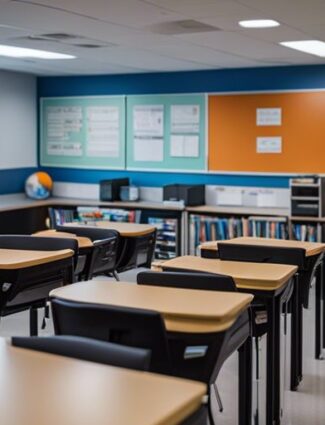test
Students
Navigating negative peer influence and maintaining motivation can be a challenging task for middle school students, but as a teacher, you have the power to guide them through these difficult times. Peer pressure can be a strong force, leading students towards negative behaviors and attitudes. However, with the right strategies in place, you can help your students resist these negative influences and stay motivated to succeed academically and personally.
One important aspect of helping your students navigate negative peer influence is building a strong rapport with them. By fostering open communication and trust, you can create an environment where students feel comfortable coming to you for guidance and support. Additionally, teaching resilience and positive coping mechanisms can empower your students to overcome the challenges posed by negative peer influence. By implementing these strategies, you can equip your students with the tools they need to navigate the complexities of middle school and emerge as confident, motivated individuals.
Key Takeaways:
- Open Communication: Encourage open communication with students to create a safe space for addressing negative peer influence.
- Positive Reinforcement: Use positive reinforcement and praise to motivate students and reinforce positive behavior.
- Teach Resilience: Provide students with tools and strategies for building resilience to navigate negative peer influence.
- Model Positive Behaviors: Model positive behaviors and healthy coping mechanisms for students to emulate.
- Establish Support Systems: Establish support systems within the school and community to provide additional resources for students in need.
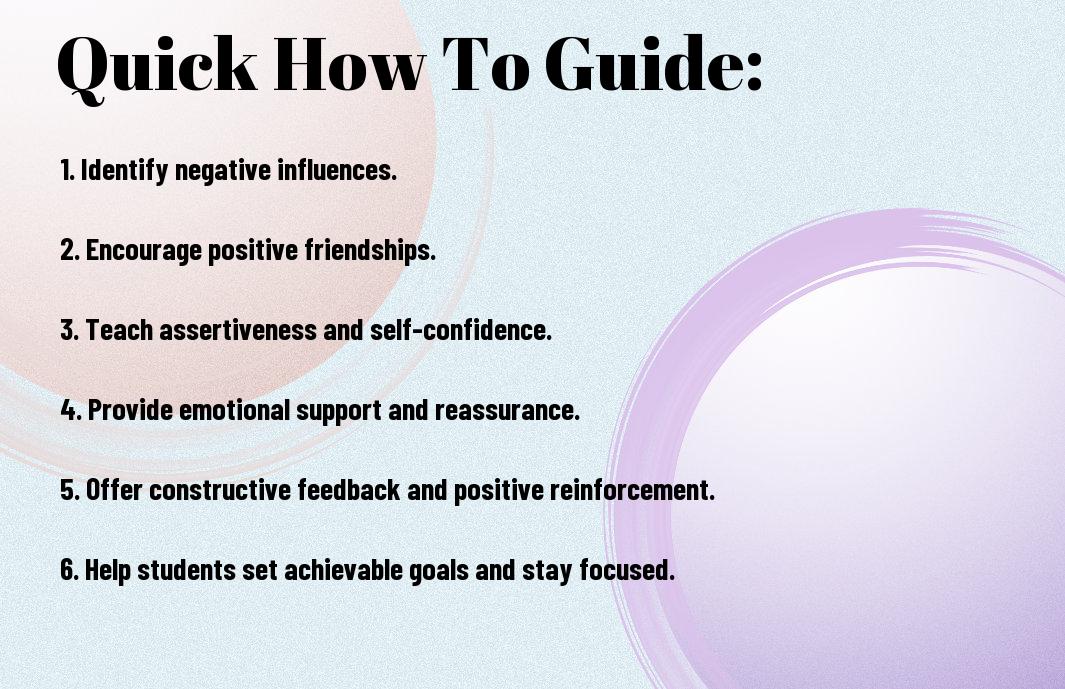
Recognizing Negative Peer Influence
Obviously, as a middle school teacher, you understand the impact that peer influence can have on students. It is important to be able to recognize when your students may be falling victim to negative peer pressure in order to intervene appropriately and help them navigate these challenging social dynamics. In this chapter, we will discuss how to identify signs of negative peer pressure and the impact it can have on student behavior.
Identifying Signs of Negative Peer Pressure
When it comes to identifying signs of negative peer pressure, it’s important to pay attention to changes in your students’ behaviors and attitudes. If you notice that a student who used to be outgoing and confident is suddenly withdrawn and anxious, it could be a sign that they are being negatively influenced by their peers. You may also observe changes in their academic performance, involvement in extracurricular activities, or their social circle. These are all potential indicators that a student is feeling the pressure of negative peer influence.
The Impact of Peer Influence on Student Behavior
Peer influence can have a significant impact on student behavior. When students are surrounded by negative peer pressure, they may engage in risky behaviors, such as substance abuse, bullying, or skipping school. It can also lead to a decline in academic performance and motivation. On the other hand, positive peer influence can have a beneficial impact on students, encouraging them to excel in their studies, develop healthy relationships, and participate in positive activities.
Strategies for Overcoming Negative Peer Influence
Now that you understand the potential impact of negative peer influence on your students, it’s important to equip them with strategies to overcome these challenges. One effective approach is to encourage positive peer relationships and empower your students to make independent choices.
Encouraging Positive Peer Relationships
One way to counteract negative peer influence is to encourage positive peer relationships. This can be achieved by fostering a classroom environment that promotes collaboration, empathy, and respect. Encourage your students to engage in group activities, collaborative projects, and peer mentoring programs. By fostering a supportive and inclusive community, you can help your students develop strong connections with their peers, making them less susceptible to negative influences. Additionally, promote open communication and conflict resolution skills to help your students navigate peer interactions effectively.
Empowering Students to Make Independent Choices
Another crucial strategy is to empower your students to make independent choices. Provide them with the knowledge and critical thinking skills to evaluate the impact of their decisions. Help them understand the consequences of their actions and the importance of setting boundaries. Encourage them to think for themselves and stand up for their values and beliefs. By empowering your students to make independent choices, you are equipping them with the confidence and resilience needed to resist negative peer influence and stay motivated in middle school.

Enhancing Student Motivation in the Classroom
Not all students are naturally motivated to succeed in the classroom, especially in the face of negative peer influence. As a teacher, it is essential to create an environment that fosters a sense of motivation and drive in your students. Here are some strategies to help enhance student motivation in the classroom and combat negative peer influence.
Creating a Supportive Learning Environment
Creating a supportive learning environment is crucial for enhancing student motivation. When students feel supported and valued, they are more likely to engage in the learning process and stay motivated. This can be achieved by fostering a sense of community in the classroom, providing positive reinforcement, and offering opportunities for students to voice their opinions and concerns. Additionally, creating a safe space for students to express themselves without fear of judgment can help combat the negative influence of their peers and keep them motivated to succeed.
Setting Achievable Goals and Rewards
Setting achievable goals and offering rewards can be powerful motivators for students. By breaking down larger tasks into smaller, manageable goals, you can help students feel a sense of accomplishment as they progress. Additionally, offering rewards for reaching these goals can provide positive reinforcement and incentivize students to stay on track. It’s important to set goals that are achievable and to tailor rewards to the interests and preferences of your students to maximize their effectiveness.
Tips for Engaging Parents and Caregivers
Keep parents and caregivers informed about the challenges their children may face from negative peer influence. Communication is key in helping to create a support system for your students. Emphasize the importance of open dialogue and active engagement to ensure a collaborative approach to addressing these issues. Here are a few strategies to help you engage parents and caregivers:
- Host regular parent-teacher meetings to discuss any concerns or challenges their child may be facing in relation to negative peer influence.
- Provide resources and support to parents and caregivers, such as information on how to recognize signs of negative peer influence and tips on how to effectively communicate with their child.
- Encourage parent involvement in school activities and events to help them feel more connected to their child’s educational experience.
Knowing that you have the support of the parents and caregivers can make a significant difference in helping your students navigate negative peer influence.
Fostering Effective Communication
When it comes to fostering effective communication with parents and caregivers, it’s important to establish a sense of trust and openness. Encourage parents to share any concerns they may have about their child’s social interactions, and be sure to provide a supportive and non-judgmental environment for these conversations. Additionally, communicate regularly with parents through newsletters, emails, or parent-teacher conferences to keep them informed about the strategies being implemented to address negative peer influence.
Collaborating on Strategies for Positive Development
Collaborating with parents and caregivers on strategies for positive development can significantly impact how students navigate negative peer influence. Encourage a partnership approach by sharing insights with parents about your observations and inviting their input on potential solutions. By working together, you can create a comprehensive support system that reinforces positive behaviors and offers a united front against negative peer influence.
Factors Contributing to Student Resilience
After conducting extensive research, it has become clear that there are several factors contributing to student resilience in the face of negative peer influence and other challenges. Here are some of the key determinants:
- Strong support system – Having a network of supportive friends and family members can significantly bolster a student’s ability to navigate negative peer influence and stay motivated in school.
- Positive mindset – Students who are able to maintain a hopeful and positive outlook are more likely to bounce back from setbacks and remain motivated despite peer pressure.
- Effective coping strategies – The ability to manage stress and cope with difficult situations is crucial for student resilience. Teaching students to develop healthy coping skills can help them stay motivated and focused on their goals.
Recognizing the importance of these factors in contributing to student resilience is crucial for educators and parents looking to support middle school students in overcoming negative peer influence.
Building Self-Esteem and Confidence
Building strong self-esteem and confidence is essential for helping students withstand negative peer influence. Encouraging students to develop a positive self-image and recognize their strengths can help them resist the pressure to conform to negative behaviors. Additionally, providing opportunities for students to succeed and receive recognition for their accomplishments can further boost their confidence and resilience.
Teaching Coping Skills and Problem-Solving
Teaching coping skills and problem-solving strategies equips students with the tools they need to navigate challenging social situations and stay motivated in the face of adversity. Encouraging students to identify their emotions, communicate effectively, and seek help when needed can empower them to handle peer influence in a healthy and productive manner. Problem-solving skills, such as critical thinking and decision-making, also play a crucial role in helping students overcome challenges and stay focused on their academic and personal goals.
How-to Implement School-Wide Programs
To address negative peer influence and keep students motivated in middle school, it’s important to implement school-wide programs that create a positive and supportive environment. These programs can help in fostering a sense of inclusivity, respect, and mentorship among students, which can in turn help them navigate through challenges and stay motivated.
Developing Peer Mentorship Initiatives
Peer mentorship initiatives play a crucial role in helping students navigate negative peer influence. By pairing older students with younger ones, you can create a support system that allows for positive role modeling and guidance. These programs can help students feel valued and supported, and provide them with positive influences to counteract negative peer pressure. Peer mentorship initiatives can help students develop social and emotional skills, build self-confidence, and provide them with a sense of belonging within the school community.
Promoting a Culture of Respect and Inclusivity
In order to combat negative peer influence and keep students motivated, it’s essential to promote a culture of respect and inclusivity within the school environment. This can be achieved through school-wide programs aimed at fostering empathy, understanding, and acceptance among students. By creating a welcoming and inclusive environment, you can help students feel valued and supported, which in turn can help them resist negative peer influence and stay motivated. Encouraging open and respectful communication, celebrating diversity, and addressing issues of bullying and discrimination can all contribute to creating a positive and inclusive school culture.
Monitoring Progress and Adapting Approaches
Your role as an educator in helping students navigate negative peer influence and stay motivated in middle school doesn’t end with implementing intervention strategies. It’s crucial to continuously monitor their progress and adapt your approaches as needed. Regularly assessing the effectiveness of your interventions and making data-driven decisions for continuous improvement are essential components of this process.
Assessing the Effectiveness of Intervention Strategies
Once you’ve implemented intervention strategies to help students deal with negative peer influence and stay motivated, it’s important to assess their effectiveness. This involves gathering data on the impact of your interventions, such as changes in student behavior, academic performance, and overall well-being. This assessment allows you to determine which strategies are working and which might need adjustment. It’s crucial to consider both quantitative data, such as academic progress and attendance records, and qualitative data, including student feedback and observations of their interactions with peers.
Making Data-Driven Decisions for Continuous Improvement
After assessing the effectiveness of your intervention strategies, it’s time to make data-driven decisions for continuous improvement. This involves analyzing the data collected to identify patterns and trends that can guide your next steps. By recognizing the most effective strategies and areas that need improvement, you can tailor your approaches to better meet the needs of your students. This iterative process of using data to inform your decisions ensures that you are constantly evolving and refining your methods to best support your students’ well-being and academic success.
Remember, staying vigilant and adaptable in your approach is the key to effectively helping your students navigate negative peer influence and stay motivated in their middle school years. By regularly monitoring progress, assessing the impact of your interventions, and making data-driven decisions for continuous improvement, you can create a supportive and empowering environment for your students to thrive.
Conclusively, Be Aware of Your Students’ Social Dynamics and Encourage Positive Relationships
By implementing the strategies discussed in this guide, you can help your students navigate negative peer influence and maintain their motivation throughout middle school. It’s important to be aware of the social dynamics within your classroom and to provide a supportive environment where students feel safe to express themselves and seek help if needed. Encouraging positive relationships and open communication can help students resist negative peer influence and stay focused on their academic and personal growth. By fostering a strong sense of community and acceptance, you can empower your students to make positive choices and stay motivated in the face of peer pressures.
FAQ
Q: What is negative peer influence in middle school?
A: Negative peer influence in middle school refers to the impact that classmates can have on each other’s attitudes and behaviors. This can include encouragement of bad habits, such as bullying, substance abuse, or skipping classes, and can have a detrimental effect on a student’s academic and personal development.
Q: How can teachers help students navigate negative peer influence?
A: Teachers can help students navigate negative peer influence by promoting open communication, fostering a positive and inclusive classroom environment, and providing guidance on how to handle peer pressure. By creating a safe space for students to express their concerns and offering resources for support, teachers can empower students to make confident decisions and resist negative influence.
Q: How can teachers keep students motivated in middle school?
A: Teachers can keep students motivated in middle school by recognizing and celebrating their achievements, offering engaging and diverse learning opportunities, and providing encouragement and support. By showing genuine interest in their students’ well-being, setting high but achievable expectations, and offering constructive feedback, teachers can help students stay motivated and committed to their academic success.
Are you tired of constantly battling with distractions in your middle school classroom? Creating a productive learning environment can be challenging, but it is essential for the success of your students. By implementing a few key strategies, you can eliminate unnecessary distractions and maximize the potential for focused and engaged learning.
First and foremost, it is crucial to establish clear expectations for behavior and attentiveness in the classroom. By setting firm guidelines from the beginning, you can reduce the likelihood of disruptive behavior and keep your students on track. Additionally, creating a structured routine and organized environment can help to minimize unnecessary distractions. Lastly, utilizing engaging and interactive teaching methods can capture and sustain your students’ attention, making it more difficult for distractions to take hold. By implementing these strategies, you can create a middle school learning environment that is free of distractions and conducive to academic success.
Key Takeaways:
- Establish clear expectations: Setting clear expectations for behavior and focus in the classroom will help students understand what is expected of them and reduce distractions.
- Create a structured routine: Establishing a routine for the day can help students stay on track and minimize opportunities for distraction.
- Utilize technology effectively: While technology can be a distraction, when used effectively, it can enhance the learning experience and keep students engaged.
- Provide alternative seating arrangements: Offering flexible seating options can help accommodate different learning styles and reduce restlessness, ultimately minimizing distractions.
- Establish positive relationships: Building positive relationships with students can help create a supportive and focused learning environment, reducing the likelihood of distractions.
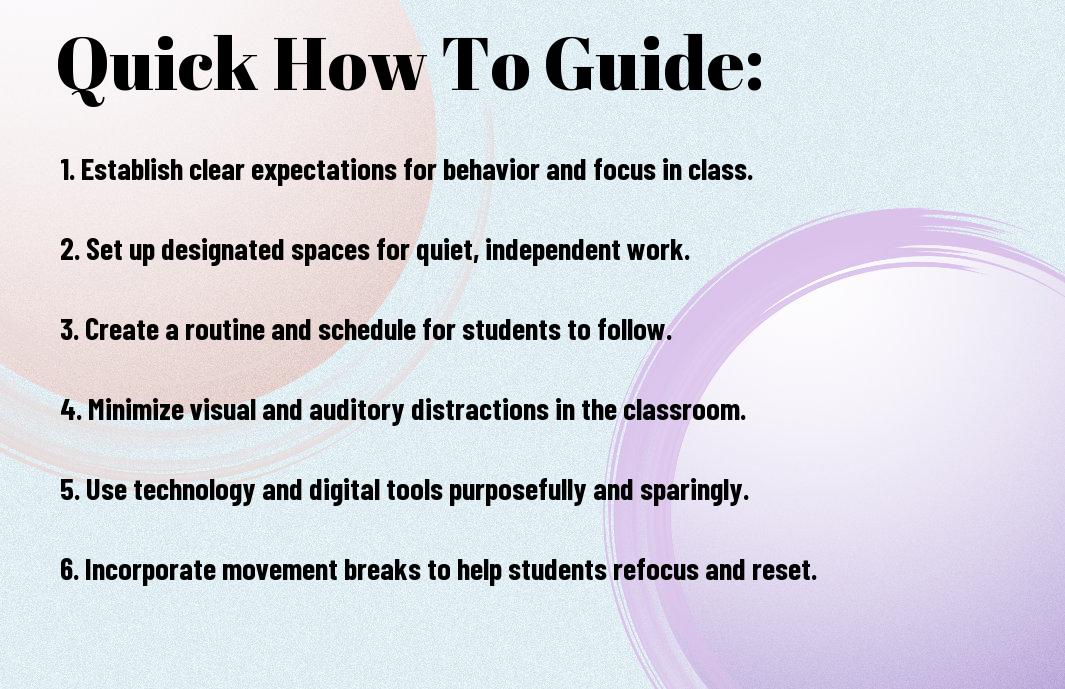
Laying the Groundwork
The key to creating a middle school learning environment free of distractions is laying a strong foundation of rules and expectations that promote focus and engagement. This begins with establishing clear rules and expectations and involving students in the process.
Establishing Clear Rules and Expectations
The first step in laying the groundwork for a distraction-free learning environment is establishing clear rules and expectations. When you have clear guidelines in place, students understand what is expected of them, which helps create a focused atmosphere. Clearly outline the classroom rules and expectations at the beginning of the school year and reinforce them consistently. Your rules should address key areas such as behavior, participation, and respect for others. It’s important to make these rules and expectations explicit and easy to understand so that there is no room for confusion.
In addition to setting clear rules, it’s crucial to outline the consequences for not following them. When consequences are clearly communicated, students understand the potential outcomes of their behavior. Consistency is key when enforcing these consequences, as it helps students understand the importance of adhering to the rules and the impact of their choices on the learning environment.
Involving Students in the Process
Another essential element of laying the groundwork for a distraction-free learning environment is involving students in the process. When students feel like they have a say in the rules and expectations, they are more likely to take ownership of their learning environment. You can involve students by asking for their input on the classroom guidelines and expectations. Encourage them to contribute ideas on what they believe will help create a focused and respectful atmosphere. By involving students in the process, they feel a sense of investment in their learning environment and are more likely to adhere to the rules and expectations that they had a hand in creating.
In addition to seeking their input, consider having students be a part of the reinforcement process. When students play a role in holding themselves and their peers accountable to the rules, they develop a deeper understanding of the importance of a distraction-free learning environment. This collaborative approach fosters a sense of responsibility and respect among students, contributing to a positive and focused learning environment.
Designing the Physical Space
Despite your best efforts to engage your students, a cluttered and disorganized classroom can easily lead to distractions. Designing your physical space with intention can significantly impact the learning environment for your middle school students. By optimizing the layout and reducing visual and auditory distractions, you can create a space that promotes focus and productivity.
Optimizing Classroom Layout for Focus
When designing the layout of your classroom, consider the arrangement of desks and seating. Ensure that every student has a clear line of sight to you and any instructional materials. Avoid placing students near windows or high-traffic areas, as these can be major distractions. Additionally, experiment with different seating arrangements to see what works best for your students. Consider grouping desks for collaboration, but be mindful of the potential for chatter and off-task behavior. Having a well-organized and uncluttered classroom will also help maintain focus and minimize distractions.
Reducing Visual and Auditory Distractions
Visual distractions, such as posters or artwork, can be stimulating but may also compete for your students’ attention. Consider reducing the number of visuals in the classroom and strategically placing them where they can enhance learning without overwhelming students. Additionally, minimize auditory distractions by controlling noise levels. If possible, use soft materials to absorb sound and consider implementing a noise policy that encourages quiet voices during independent work time. Creating a calm and quiet physical environment will help your students concentrate and absorb information more effectively.
Integrating Technology Effectively
Your middle school learning environment can benefit greatly from the effective integration of technology. It can enhance engagement, facilitate collaboration, and provide access to a wealth of resources. However, it is essential to use technology in a way that minimizes distractions and maximizes learning opportunities.
Balancing Technology Use with Restrictions
When incorporating technology into the classroom, it is crucial to strike a balance between leveraging its benefits and imposing necessary restrictions. Implementing clear guidelines and expectations for technology use can help create a focused learning environment. For example, you can establish designated times for device use and emphasize the importance of staying on task during academic activities. Additionally, consider implementing filtering and monitoring systems to ensure that students are accessing appropriate content and staying on track with their educational objectives.
Tools and Apps to Enhance Learning Without Distraction
There are various tools and apps that can enhance learning without introducing unnecessary distractions. Interactive whiteboards and educational software can be utilized to deliver engaging lessons and interactive activities. Similarly, note-taking and organizational apps can help students stay organized and focused on their academic responsibilities. By incorporating these tools thoughtfully, you can create an environment that leverages technology’s potential while minimizing disruptions.
Encouraging Positive Behavior
After creating a learning environment free of distractions, the next step is to encourage positive behavior among your middle school students. By setting clear expectations and providing support and guidance, you can foster a classroom environment that promotes focus and engagement.
Reward Systems for Maintaining Focus
One effective way to encourage positive behavior and maintain focus is to implement a reward system. By offering incentives for staying on task and participating actively in class, you can motivate your students to prioritize their learning. This could include small rewards such as extra recess time, classroom privileges, or even a special reward day at the end of the week for those who consistently demonstrate good behavior. It’s important to communicate the specific criteria for earning these rewards, so that students know exactly what is expected of them. Additionally, be sure to consistently follow through with the rewards, as this will reinforce the positive behavior you are seeking to promote.
Managing Disruptive Behavior Proactively
Despite your best efforts, there may still be instances of disruptive behavior in the classroom. It’s important to address these situations proactively to prevent them from escalating and causing further distractions. When you observe disruptive behavior, it’s crucial to intervene calmly and respectfully. First, address the situation privately with the student involved, using a neutral tone and focusing on the specific behavior that needs to change. It’s important to offer support and guidance to help the student understand the impact of their behavior and find alternative ways to handle their emotions. By intervening immediately and offering constructive feedback, you can help prevent further disruptions and maintain a positive learning environment for everyone.
Involving Parents and Guardians
For a middle school learning environment free of distractions, involving parents and guardians is crucial. When you work together with parents, you can create a cohesive support system that promotes focus and minimizes distractions for the students.
Fostering Home-School Communication
Establishing open lines of communication between the school and home is essential for maintaining a distraction-free learning environment. Encourage parents to regularly check in with teachers, attend parent-teacher conferences, and stay updated on their child’s progress. This ongoing communication allows for early identification and resolution of any potential issues that could affect focus and learning. It also helps create a sense of accountability for both the student and the parent, reinforcing the importance of a distraction-free environment at home.
Strategies for Supporting Focus at Home
Provide parents and guardians with practical strategies for supporting focus at home. This may include setting up a designated study space, creating a daily routine, and establishing clear expectations for homework and device usage. Encourage parents to help their child manage their time effectively, limit screen time, and create a quiet and organized environment for studying. Additionally, offering guidance on how to support their child’s mental and emotional well-being can contribute to a focused and productive learning environment at home.
It is important to emphasize the role that parents play in creating an environment conducive to learning and focus at home. By maintaining open communication and implementing practical strategies, you can help ensure that students have the support they need to thrive academically.
Adjusting to Individual Needs
Keep in mind that every student in your classroom is unique and has their own set of individual needs when it comes to learning. It’s important to recognize that not all students learn in the same way or at the same pace. By making adjustments to accommodate different learning styles and special needs, you can create a more inclusive and distraction-free learning environment for your middle school students.
Identifying and Accommodating Different Learning Styles
When it comes to creating a distraction-free learning environment, it’s crucial to identify and accommodate different learning styles. Some students may be visual learners, others auditory learners, and some may be kinesthetic learners. By incorporating a variety of teaching methods and resources, you can ensure that you are catering to the individual learning styles of all your students. Providing visual aids, incorporating group discussions, and allowing for hands-on activities can help engage students and minimize distractions. Additionally, offering choices in how students can demonstrate their understanding of the material can empower them to take ownership of their learning.
Supporting Students with Special Needs
Supporting students with special needs is essential in creating an inclusive and distraction-free learning environment. It’s important to be aware of the specific needs of each student and provide accommodations as necessary. This may include providing additional support in the form of a teacher’s aide, using assistive technology, or allowing for extended time on assignments and tests. By being understanding and flexible, you can create a supportive and nurturing environment that allows all students to thrive. Remember, every student has the right to an education free of distractions, and it’s your responsibility as an educator to ensure that all students are given the resources they need to succeed.

Monitoring and Adapting the Environment
Not only is it important to set up a distraction-free learning environment, but it is equally crucial to continuously monitor and adapt the space to ensure it remains conducive to learning. By regularly assessing the learning space for distracting elements and continuously seeking feedback, you can maintain an environment that supports students’ focus and engagement.
Regularly Assessing the Learning Space for Distracting Elements
Regularly evaluating the learning space for potential distractions is essential in maintaining an optimal environment for middle school students. Start by conducting a visual scan of the classroom to identify any clutter, visual disturbances, or potential noise sources. Keep an eye out for any items that may be drawing attention away from the learning process, such as posters, decorations, or even excessive supplies. Additionally, consider the arrangement of furniture and seating to ensure that it promotes a sense of calm and concentration.
Continuous Improvement Through Feedback
Continuous improvement through feedback is a valuable tool in the quest to create a distraction-free learning environment. Encourage open communication with your students and ask for their input on how the learning space can be improved. You can also seek feedback from other educators, parents, and even outside consultants to gain different perspectives on the effectiveness of the environment. By listening to and considering the feedback you receive, you can implement changes that will have a positive impact on the learning experience and overall engagement of your students.
Remember that creating a distraction-free learning environment is an ongoing process. By regularly assessing the space for distracting elements and seeking feedback for continuous improvement, you ensure that the middle school learning environment remains conducive to student focus and success. With dedication and attention to detail, you can create an environment that supports student learning and minimizes distractions, ultimately enhancing their educational experience.
Conclusion
So, now that you have learned about the various steps and strategies for creating a middle school learning environment free of distractions, it is important for you to take action. By implementing clear guidelines for behavior, utilizing technology wisely, and incorporating engaging activities that stimulate focus, you can help cultivate a classroom setting that is conducive to learning and academic success. Remember that you play a crucial role in shaping the learning environment, and by being proactive and consistent, you can help minimize distractions and create a space where students can thrive.
It is crucial to constantly monitor and adapt your approach to ensure that distractions are kept to a minimum. By consistently reinforcing expectations and providing a supportive and structured environment, you can help students stay focused and engaged in their learning. With determination and perseverance, you can create a middle school learning environment that is free of distractions and promotes a positive and productive educational experience for all students.
FAQ
Q: Why is it important to create a middle school learning environment free of distractions?
A: Creating a distraction-free learning environment in middle school is crucial for promoting focus, engagement, and academic success. Minimizing distractions can help students to stay on task, retain information, and develop important study habits that will benefit them throughout their academic careers.
Q: What are some strategies for creating a distraction-free middle school learning environment?
A: Several strategies can be implemented to create a distraction-free learning environment in a middle school setting. These include organizing the classroom to minimize visual and auditory distractions, establishing clear expectations for behavior and participation, and utilizing tools such as noise-canceling headphones or designated quiet areas for individual work.
Q: How can teachers and administrators support the creation of a distraction-free learning environment in middle school?
A: Teachers and administrators can support the creation of a distraction-free learning environment by modeling focused behavior, providing consistent feedback on classroom behavior, and implementing technology policies that limit access to distractions during instructional time. Additionally, collaboration with parents and guardians to reinforce distraction-free behaviors at home can further support the efforts to create an optimal learning environment.
Do you find yourself grappling with a lack of motivation when it comes to studying in middle school? It’s a common challenge for many students, but creating a supportive study environment can make a world of difference. By implementing some key strategies and making a few changes to your study space, you can combat those feelings of lack of motivation and set yourself up for academic success.
First and foremost, it’s important to eliminate distractions in your study space. This means finding a quiet, clutter-free area where you can focus without interruptions. Additionally, surrounding yourself with motivational quotes, posters or images that inspire you can help keep you in the right mindset. It’s also crucial to establish a consistent study routine and set realistic goals for yourself. With the right environment and mindset, you’ll be well on your way to overcoming lack of motivation and excelling in your studies.
Key Takeaways:
- Establish a dedicated study space: Providing a specific, comfortable space for middle schoolers to study can help them stay focused and motivated.
- Limit distractions: Minimizing noise and technology can help create an environment conducive to studying and combat lack of motivation.
- Encourage organization: Teaching middle schoolers how to stay organized with their materials and assignments can help reduce stress and increase motivation.
- Offer positive reinforcement: Praising effort and progress can help boost motivation and create a supportive study environment.
- Provide resources and support: Offering access to educational resources and being available to provide support and guidance can help motivate middle schoolers to succeed academically.
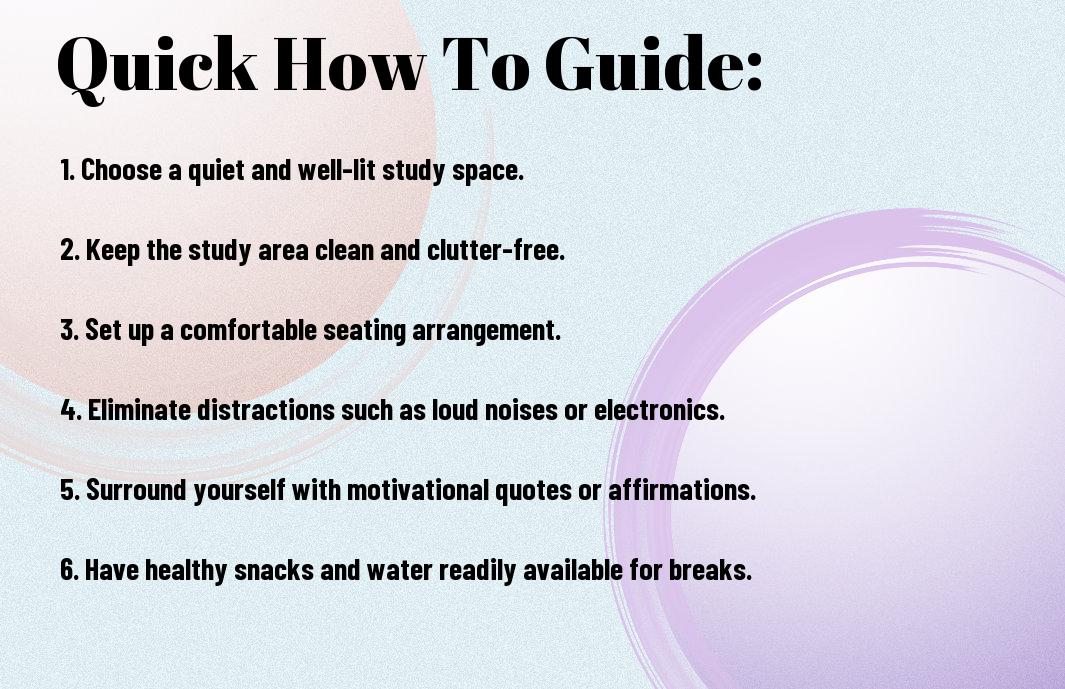
Assessing the Current Study Environment
Clearly, one of the first steps in creating a supportive study environment for middle school students is to assess the current state of their study space. This involves taking a close look at the physical setting and evaluating the potential distractions and barriers that may be hindering their motivation and focus.
Identifying Distractions and Barriers
When assessing the study environment, it’s important to identify any potential distractions and barriers that may be impeding your ability to concentrate and stay motivated. This could include a cluttered or disorganized workspace, noisy surroundings, or even digital distractions such as social media and electronic devices. Identifying and addressing these distractions is crucial to creating an environment that fosters motivation and productivity.
Surveying Student Needs and Preferences
Another important aspect of assessing the study environment is surveying your own needs and preferences. Take some time to think about what kind of environment helps you feel most focused and motivated. Consider factors such as lighting, noise level, and the layout of your workspace. Additionally, think about any specific tools or resources that you find helpful, such as highlighters, sticky notes, or a comfortable chair. Understanding your own needs and preferences will help you tailor your study environment to best support your learning and motivation.
Fundamental Elements of a Supportive Study Space
Not having a supportive study environment can make it difficult for you to stay motivated and focused on your studies. Creating a supportive study space is essential for combating lack of motivation and ensuring that you can perform to the best of your abilities.
Ergonomics and Comfort
When it comes to creating a supportive study environment, ergonomics and comfort play a crucial role. It’s important to ensure that your study space is set up in a way that supports good posture and reduces the risk of discomfort or pain. This means having a comfortable chair and desk that are at the correct height for you. Your computer monitor should be at eye level, and your keyboard and mouse should be positioned so that your arms and wrists are in a neutral position to prevent strain.
Lighting, Noise, and Temperature
Another essential aspect of a supportive study space is the right lighting, noise level, and temperature. Poor lighting can cause eye strain and fatigue, so it’s important to have adequate lighting that is evenly distributed throughout your study area. Additionally, excessive noise can be distracting and make it difficult for you to concentrate, so choose a quiet location if possible. Finally, maintaining a comfortable temperature is essential for a supportive study space – a room that is too hot or too cold can negatively impact your ability to focus and retain information.
Psychological Factors in Creating a Motivating Study Environment
Now, let’s delve into the psychological factors that play a crucial role in creating a motivating study environment. By being mindful of these factors, you can effectively combat lack of motivation and cultivate a supportive space for successful studying. Recognizing the impact of psychological factors is fundamental in tailoring your study environment to cater to your needs and enhance your motivation.
Color Theory and Visual Stimuli
When it comes to creating a motivating study environment, color theory and visual stimuli play a significant role. The colors in your surroundings can have a profound impact on your mood and productivity. For example, incorporating warm tones such as red, yellow, or orange can evoke feelings of energy and optimism, while cool tones like blue and green can promote a sense of calm and focus.
Incorporating Elements of Nature
Bringing elements of nature into your study environment can have a therapeutic and motivating effect. Plants, natural light, and nature-inspired artwork can create a sense of tranquility and connectedness, leading to reduced stress and increased focus. By surrounding yourself with elements of nature, you can enhance
Structuring Time and Routine for Optimal Focus
To combat lack of motivation, it’s important to structure your time and routine in a way that promotes optimal focus and productivity. Creating a consistent schedule and sticking to it can help you establish a sense of routine and discipline, which can in turn boost your motivation and overall academic performance.
Time Management Strategies for Study Sessions
When it comes to studying, effective time management is crucial. Prioritize your tasks and allocate specific time slots for each subject or assignment. This will help you stay on track and prevent procrastination. Additionally, consider using time management techniques such as the Pomodoro Method, where you work for 25 minutes and then take a 5-minute break. This can help you stay focused and maintain a balance between productivity and rest.
The Role of Breaks and Downtime
It’s important to recognize the significance of breaks and downtime in maintaining motivation and focus. Taking short, regular breaks during study sessions can prevent burnout and mental fatigue. Use this time to relax, stretch, or engage in activities that refresh your mind and body. However, be mindful not to overindulge in downtime, as this can lead to procrastination and hinder your progress. Striking a balance between work and rest is essential for sustaining motivation and productivity.
The Social Aspect of Studying
Keep in mind that studying is not just an individual activity – the social aspect of studying is just as important for your motivation and success. Creating a supportive study environment also involves considering your social interactions and finding ways to make the most of them.
Encouraging Peer Support and Group Study
One way to combat lack of motivation in middle school is by encouraging peer support and group study. Collaborating with your peers can be incredibly beneficial, as it allows you to share your knowledge and learn from others. Working with peers can also help keep you accountable, as you can set study goals and check in with each other regularly. Additionally, discussing and debating topics with classmates can help you gain a deeper understanding of the material.
Balancing Independence and Collaborative Learning
While peer support and group study can be valuable, it is also important to strike a balance between independent and collaborative learning. Independence is crucial for developing critical thinking skills and self-discipline, so make sure to allocate sufficient time for individual study as well. However, don’t be afraid to seek help from your peers when you encounter challenging concepts – collaborative learning can provide fresh perspectives and support when you’re feeling stuck.

Leveraging Technology and Resources
For middle school students, leveraging technology and resources can significantly enhance the study environment and provide the motivation needed to excel academically. By incorporating educational tools and apps, as well as creating a resource center for self-paced learning, you can create an environment that fosters a positive attitude towards studying and learning.
Choosing the Right Educational Tools and Apps
When it comes to choosing educational tools and apps for middle school students, it’s important to select ones that are engaging, interactive, and aligned with the curriculum. Look for tools and apps that offer personalized learning experiences, adaptive feedback, and the ability to track your progress. Whether it’s a math app that provides interactive exercises or a language learning tool that offers real-life conversations, the right educational tools and apps can make studying more enjoyable and effective.
Creating a Resource Center for Self-Paced Learning
Creating a resource center for self-paced learning allows you to tailor your study environment to your own pace and learning style. One of the most effective ways to achieve this is by curating a collection of educational resources such as textbooks, online courses, educational videos, and interactive learning platforms. By having a variety of resources at your disposal, you can choose the most suitable materials for your individual learning needs and preferences. This not only enhances your ability to learn at your own pace, but also fosters a sense of independence and control over your education.
Involving Parents and Guardians in the Study Process
After creating a supportive study environment in your middle schooler’s home, it’s important to involve parents and guardians in the study process. Collaborating with parents can greatly contribute to your child’s academic success and motivation. When parents are actively involved in their child’s education, students tend to have better attendance, higher grades, and an increased likelihood of pursuing higher education. Here are some strategies to involve parents and guardians in your middle schooler’s study process.
Communication Strategies Between School and Home
Effective communication between the school and home is essential for creating a supportive study environment for your middle schooler. Regularly update parents about their child’s academic progress, behavior, and any areas of concern. Encourage open lines of communication between parents and teachers, allowing for dialogue about the child’s performance and needs. It is important for parents to feel informed and included in their child’s educational journey. Utilize parent-teacher conferences, progress reports, and digital platforms to keep parents informed and engaged in their child’s academic life.
Supporting the Study Environment Beyond the Classroom
Supporting your middle schooler’s study environment beyond the classroom is crucial for their academic success. Encourage parents to create a designated study space at home, free from distractions, and equipped with necessary study materials. Establish a routine for homework and studying, and encourage parents to help their child develop effective time management skills. Additionally, provide resources and guidelines to parents on how to support their child’s learning at home. Encouraging parental involvement in helping with homework, discussing academic goals, and providing emotional support can significantly impact your middle schooler’s motivation and success.
By involving parents and guardians in the study process, you are creating a network of support for your middle schooler’s academic journey. This collaboration between school and home can contribute to the overall motivation and success of your child. Remember, you play a pivotal role in shaping your child’s study environment, so take advantage of the opportunity to involve parents and guardians in supporting your middle schooler’s academic pursuits.
Monitoring Progress and Adapting Strategies
Despite your best efforts to create a supportive study environment, it’s important to recognize that your approach may need to evolve as your middle schooler’s needs change. Monitoring your child’s progress and adapting your strategies accordingly is key to maintaining motivation and success in their studies. This chapter will provide you with practical tips for staying on top of your child’s progress and making necessary adjustments to their study environment.
Setting Achievable Goals and Milestones
Setting achievable goals and milestones is essential in keeping your middle schooler motivated and focused on their studies. Encourage your child to set specific, measurable, and attainable goals for their academic performance. Whether it’s aiming for a certain grade on a test or completing a project by a set deadline, these goals can provide a sense of direction and purpose. Additionally, breaking down larger tasks into smaller, more manageable milestones can help your child stay motivated by allowing them to celebrate their progress along the way.
Regularly Assessing and Adjusting the Study Environment
It’s critical to regularly assess the effectiveness of your child’s study environment and make adjustments as needed. Pay attention to any changes in your child’s behavior, such as increased frustration or lack of focus, as these may indicate that their current study environment is no longer conducive to learning. Consider factors such as noise levels, lighting, and comfort, and make changes to create a more positive and conducive space for studying. Additionally, be open to feedback from your child about what is and isn’t working for them in their study environment, and make adjustments accordingly. By regularly assessing and adjusting the study environment, you can ensure that your middle schooler has the best chance of staying motivated and successful in their studies.
Creating a Supportive Study Environment to Combat Lack of Motivation in Middle School
Hence, creating a supportive study environment is crucial in combating lack of motivation in middle school. By understanding the factors that contribute to lack of motivation and actively taking steps to address them, you can significantly improve your motivation to study and succeed in your academic journey. Remember to incorporate elements such as organization, a designated study space, and positive reinforcement to create an environment that fosters motivation and productivity. Additionally, seeking support from teachers, parents, and peers can also play a key role in staying motivated and engaged in your studies.
It’s important to regularly evaluate and adjust your study environment to ensure it remains conducive to your academic goals. By taking the time to create a supportive study environment, you are investing in your own success and setting yourself up for a fulfilling and rewarding middle school experience.
FAQ
Q: Why is it important to create a supportive study environment for middle school students?
A: A supportive study environment is crucial for middle school students as it helps combat lack of motivation and provides a conducive space for learning. It can positively impact their academic performance, attitude towards studying, and overall well-being.
Q: What are some practical ways to create a supportive study environment at home?
A: To create a supportive study environment, designate a quiet and well-lit study area free from distractions. Encourage positive study habits such as time management and organization. Provide necessary school supplies and resources, and offer guidance and support when needed.
Q: How can parents and teachers collaborate to maintain a supportive study environment for middle school students?
A: Collaboration between parents and teachers is essential. Regular communication about a student’s progress, challenges, and successes is key. Parents can reinforce the importance of education at home, while teachers can provide guidance on effective study methods and offer additional support if needed.
At this crucial stage of academic development, it is imperative to address the issue of distractions in order to maximize learning potential. As a middle school student, you are constantly bombarded with distractions, whether it’s from social media, friends, or personal thoughts. However, it’s important to recognize that overcoming these distractions is essential for academic success.
When it comes to helping middle school students overcome distractions, it’s crucial to establish a structured and consistent environment that fosters focus. This blog post will provide practical and effective strategies to help you minimize distractions and improve your learning experience. Whether you struggle with staying focused in the classroom or while studying at home, implementing the tips outlined in this post will empower you to take control of your learning and academic success.
Key Takeaways:
- Establish Clear Expectations: Setting clear guidelines and expectations for behavior can help students stay focused and minimize distractions in the classroom.
- Teach Time Management Skills: Teaching students how to manage their time effectively can help them prioritize tasks and avoid getting sidetracked by distractions.
- Provide a Structured Environment: Creating a structured and organized learning environment can help minimize distractions and encourage focused attention on academic tasks.
- Utilize Positive Reinforcement: Using positive reinforcement and rewards for staying on task can motivate students to overcome distractions and stay focused on their learning.
- Encourage Open Communication: Encouraging open communication and addressing individual student needs can help identify and remove specific distractions that may be hindering their learning.
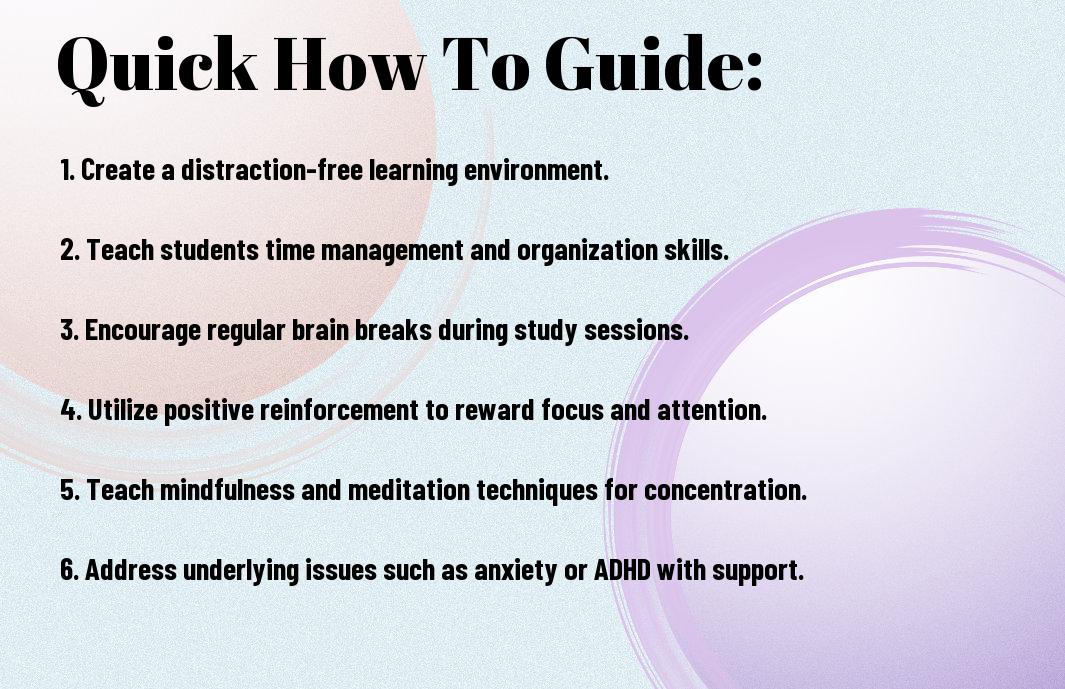
Understanding Distractions in Middle School
Obviously, middle school can be a challenging time for students. With the transition from elementary to high school, they are exposed to a myriad of distractions that can hinder their learning process. It’s important to understand the nature of these distractions in order to effectively help students overcome them and improve their focus in the classroom.
Common Distractions for Middle School Students
One of the most common distractions for middle school students is social interactions. As they navigate through the complexities of peer relationships and social dynamics, it’s easy for them to get caught up in conversations and gossip, taking their attention away from the task at hand. Additionally, the prevalence of digital devices and social media platforms can also be a significant source of distraction for students. The constant notifications and temptation to check their phones can lead to a lack of focus during class.
Factors Contributing to Distractions
There are several factors that contribute to distractions in middle school. Puberty and hormonal changes can lead to emotional instability and mood swings, affecting students’ ability to concentrate. The increasing academic workload and pressure to perform well academically can also overwhelm students, causing them to lose focus. Moreover, environmental factors such as noisy classrooms or uncomfortable seating arrangements can make it difficult for students to concentrate on their studies.
- Hormonal changes: Puberty can lead to emotional instability and mood swings, affecting concentration.
- Academic pressure: Increasing academic workload and pressure to perform well can be overwhelming for students.
- Environmental factors: Noisy classrooms or uncomfortable seating arrangements can hinder concentration.
The combination of these factors can create a challenging environment for middle school students to stay focused on their studies. The key is to recognize these distractions and implement strategies to help students overcome them.

Preparing the Environment
Not only are distractions in middle school pervasive, but they are also challenging to overcome. It is important to create an environment that promotes focus and concentration. A distraction-free environment can make a significant difference in a student’s ability to learn and retain information.
Tips for Creating a Distraction-Free Study Area
The first step in preparing a distraction-free environment is to create a dedicated study area. This area should be free from clutter and noise, allowing you to focus solely on your studies. Consider the following tips to create an ideal study environment:
- Find a quiet space where you can concentrate without interruptions. Minimizing noise and distractions will help you stay focused.
- Ensure your study area is well-lit to prevent eye strain and fatigue.
- Remove any non-essential items from your study area, such as electronic devices or toys, to eliminate temptations and maintain focus.
Recognizing the importance of creating a distraction-free study area can greatly impact your ability to concentrate and improve your overall learning experience.
The Role of Classroom Design in Minimizing Distractions
Classroom design plays a crucial role in minimizing distractions for middle school students. A well-organized and structured classroom can contribute to a positive learning environment. Consider the following factors when evaluating the role of classroom design in minimizing distractions:
- Seating arrangements should be strategically planned to minimize distractions and promote engagement with the lesson.
- Classroom decor should be minimal and purposeful to avoid overwhelming students with excessive visual stimuli.
- Technology should be integrated thoughtfully to enhance the learning experience without becoming a source of distraction.
By acknowledging the impact of classroom design on student focus and engagement, you can better advocate for an optimal learning environment.
Establishing Routines
Now that you understand the impact of distractions on middle school students, let’s talk about how you can help them overcome these distractions to improve their learning. One of the most effective methods for managing distractions is to establish solid routines for students. Consistent schedules and built-in breaks can help students stay focused and on track with their learning.
The Power of Consistent Schedules
Consistent schedules are crucial for helping middle school students overcome distractions and improve their learning. When you establish a routine, you provide a sense of predictability and stability for students. This can help reduce anxiety and uncertainty, allowing them to focus more on their studies. When students know what to expect, they are better able to prepare themselves mentally and emotionally for the tasks at hand. Additionally, consistent schedules provide a structure that can help students stay organized and manage their time effectively. This can ultimately lead to improved academic performance and a more positive learning experience overall.
Building Breaks and Rewards into Learning Sessions
Building breaks and rewards into learning sessions can also help students overcome distractions and improve their learning. Breaks allow students to recharge their energy and refocus their attention, which can lead to better concentration and retention of information. By incorporating regular breaks into the learning schedule, you are giving students the opportunity to rest and reset, ultimately boosting their productivity and performance. Rewards can also serve as powerful motivators for students, encouraging them to stay on task and complete their work. By offering incentives for their efforts, you can help students stay engaged and motivated to overcome distractions and achieve their academic goals. Research has shown that positive reinforcement can have a significant impact on students’ behavior and performance, making it a valuable tool for improving learning outcomes.
Establishing routines, incorporating consistent schedules, and building breaks and rewards into learning sessions are essential strategies for helping middle school students overcome distractions and improve their learning. By providing a structured and supportive environment, you can help students stay focused and motivated, ultimately leading to better academic success and a positive learning experience.
Utilizing Technology Wisely
Unlike in the past, technology is now an integral part of education and can be a powerful tool for learning in middle school. However, with the myriad of distractions that come with technology, it is essential to use it wisely to help students stay focused and improve their learning experience. Here are some ways to utilize technology wisely to minimize distractions and enhance learning in middle school.
Apps and Tools to Enhance Focus
There are a variety of apps and tools designed to help students stay focused and organized. For example, apps like Forest and StayFocusd can help you stay on track by blocking distracting websites and apps for a set period of time, allowing you to concentrate on your schoolwork. Additionally, tools like Google Calendar and Trello can help you manage your time and tasks effectively, reducing the likelihood of digital distractions.
Guidelines for Reducing Digital Distractions
When utilizing technology for learning, it’s important to establish guidelines for reducing digital distractions. Set specific times for using devices for school-related tasks and establish boundaries for recreational screen time. Consider implementing a “no phones during study time” rule to help you focus on your assignments without the temptation of checking social media or playing games. Creating a conducive environment for learning by minimizing digital distractions can significantly improve your ability to concentrate and absorb new information.
Strategies for Individual Challenges
To help students overcome distractions in middle school and improve learning, it’s important to address individual challenges. Every student faces unique obstacles that can hinder their ability to focus and absorb information. In this chapter, we will discuss strategies to assist students with special learning needs and tailor approaches for different types of learners.
How to Help Students with Special Learning Needs
When it comes to supporting students with special learning needs, it’s crucial to provide personalized assistance. Some students may require accommodations such as extra time on assignments or access to assistive technology. It’s important to collaborate with their parents and school professionals to create an individualized education plan that meets their specific requirements. Additionally, offering extra support and encouragement can go a long way in boosting their confidence and helping them succeed academically.
Tailoring Approaches for Different Types of Learners
Every student has a unique learning style, and it’s essential to tailor your teaching approach accordingly. Some students are visual learners, while others may excel with hands-on activities. By identifying your students’ preferred learning styles, you can adjust your lesson plans to cater to their individual needs. Providing a variety of learning materials and incorporating your student’s interests into your lessons can also help keep them engaged and focused. After all, you want to create an environment where every student feels valued and supported in their learning journey.
| Special Learning Needs | Different Types of Learners |
|---|---|
| Personalized assistance | Identifying learning styles |
| Collaboration with parents and professionals | Tailoring teaching approach |
| Extra support and encouragement | Providing a variety of learning materials |
| Creating individualized education plans | Incorporating students’ interests into lessons |
| Boosting confidence and academic success | Keeping students engaged and focused |
Involving Parents and Guardians
For middle school students, involving parents and guardians in their education can be crucial for overcoming distractions and improving learning. Your role as a parent is essential in addressing the challenges your child may face and supporting their academic success. Here are a few ways in which you can get involved in your child’s education:
Communicating About Student Progress and Challenges
Communication with teachers about your child’s progress and challenges is key to addressing distractions and helping them succeed in middle school. Regularly check in with your child’s teachers to understand how they are doing in their classes, and ask about any areas where they may need extra support. Stay informed about their academic performance, behavior, and any areas where they may be struggling. This open line of communication can help you and the teachers work together to address any distractions and help your child thrive in their learning environment.
How Parents Can Support Learning at Home
As a parent, you play a vital role in supporting your child’s learning at home. Creating a positive and distraction-free study environment will greatly benefit your child’s ability to focus and learn. Ensure that there is a designated space for studying that is quiet, well-lit, and free from distractions such as TV, video games, or other electronic devices. Encourage your child to establish a consistent study routine and help them stay organized with their schoolwork and assignments. Additionally, showing a genuine interest in their academic pursuits and providing encouragement and support can go a long way in helping your child overcome distractions and achieve academic success.
Measuring Progress and Making Adjustments
After implementing strategies to help students overcome distractions, it’s important to measure their progress and make any necessary adjustments. This will ensure that the efforts being put in place are effective and are actually helping the students improve their learning outcomes.
Monitoring Student Improvement
As you begin to implement strategies to help students overcome distractions, it’s important to monitor their improvement. You can do this by tracking their academic performance, behavior in the classroom, and their ability to stay focused on tasks. Keep a close eye on their test scores, class participation, and completion of assignments. Additionally, you can collect feedback from the students themselves and their parents to gain insight into their progress. This will help you identify any areas where they may still be struggling and require further support.
Adapting Techniques for Better Results
While monitoring student improvement, you may find that certain techniques are more effective than others. It’s important to be flexible and adapt your strategies to better suit the needs of the students. For example, if you find that a particular method of minimizing distractions is not working for a particular student, you may need to try a different approach. Additionally, you can seek feedback from the students and involve them in the process of finding strategies that work best for them. This collaborative approach can help create a more positive and conducive learning environment.
By monitoring student improvement and adapting techniques for better results, you can ensure that the strategies you are implementing are effectively helping students overcome distractions and improve their learning outcomes. Remember to stay flexible and open to making adjustments as needed to best support the individual needs of your students. By doing so, you can ensure that they are receiving the necessary support to excel academically and overcome distractions.
How to Help Students Overcome Distractions in Middle School to Improve Learning
Taking this into account, it is crucial to recognize the impact of distractions on a student’s ability to learn and succeed in middle school. By implementing strategies such as creating a structured and organized learning environment, fostering positive study habits, and introducing mindfulness techniques, you can help students overcome distractions and improve their focus and concentration during the learning process. Additionally, providing individual support and guidance to students who struggle with distractions can make a significant difference in their academic performance. By addressing distractions proactively and offering the necessary support, you can empower students to excel in their studies and develop essential skills for success in the classroom and beyond.
FAQ
Q: Why is it important to help students overcome distractions in middle school?
A: It is important to help middle school students overcome distractions because it can significantly impact their ability to learn and retain information. Distractions can lead to poor concentration, reduced academic performance, and hinder their overall learning experience.
Q: What are some common distractions in middle school?
A: Common distractions in middle school include social media, electronic devices, peer pressure, lack of organization, noisy classroom environments, and personal issues. These distractions can disrupt a student’s focus and hinder their learning process.
Q: How can we help students overcome distractions in middle school to improve learning?
A: To help students overcome distractions, it is important to create a structured and organized learning environment, establish clear expectations and consequences for distractions, teach time management and self-regulation skills, provide support for personal issues, limit access to electronic devices during learning time, and encourage open communication with students about managing distractions.
In the modern world, the ubiquity of technology can often lead to a disconnect between learning and screen time. As a middle school student, it’s important to find a healthy balance between the two in order to ensure you are maximizing your educational experience. With the right strategies and mindset, you can effectively integrate technology into your learning while still prioritizing academic growth.
One of the most critical aspects of balancing technology use and learning in middle school is setting boundaries for yourself. This means establishing designated times for technology use for recreational purposes, while also ensuring that you have ample time for focused, uninterrupted learning. Additionally, it’s crucial to be mindful of the type of technology you are using for learning – not all platforms and devices are created equal, and selecting the right tools can make a significant difference in your academic success. By taking proactive steps to manage your technology use, you can create an environment that fosters both learning and digital engagement in a healthy and balanced manner.
Key Takeaways:
- Establish clear guidelines: Setting clear rules and expectations for technology use in the classroom can help students to maintain focus on learning.
- Encourage responsible use: Teaching students about the appropriate use of technology and digital citizenship can help them to navigate their online activities in a safe and productive manner.
- Provide a balanced approach: Offering a mix of technology-based and traditional learning activities can help to create a well-rounded educational experience for middle school students.
- Model positive tech behaviors: Educators should demonstrate responsible and mindful use of technology to set a positive example for their students.
- Regularly assess tech integration: Periodically evaluating how technology is being used in the classroom can help to ensure that it is effectively supporting student learning and engagement.
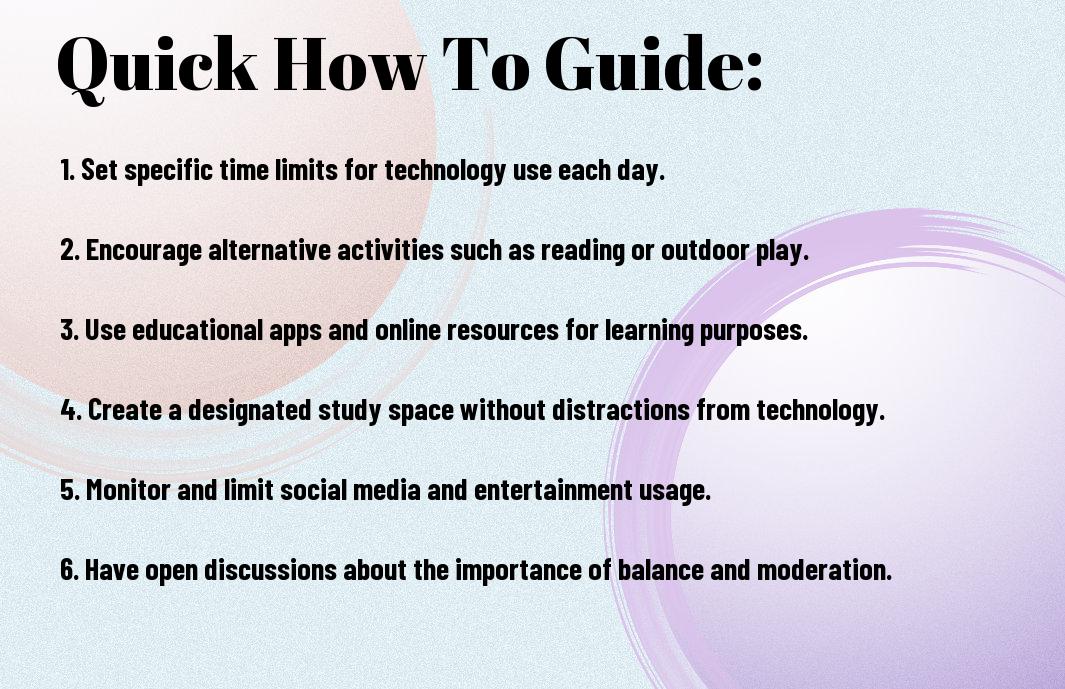
Evaluating Current Technology Use
Obviously, technology plays a crucial role in the lives of middle school students today. It’s important for you to evaluate your current technology use in order to strike a balance between staying connected and focused on learning. This assessment will help you identify areas of improvement and make necessary changes to create a healthy technology and learning environment.
Assessing Screen Time and Usage Patterns
When evaluating your technology use, it’s important to assess your screen time and usage patterns. Look at how much time you spend on your devices each day and the activities you engage in. Are you spending too much time on social media, gaming, or other non-educational activities? Consider keeping a log of your screen time for a week to gain a better understanding of your usage patterns. This will help you identify any excessive or harmful technology habits that need to be addressed.
Identifying Educational vs. Distractive Technology Use
Another aspect to consider when evaluating your technology use is distinguishing between educational and distractive use. Are you using technology to enhance your learning, research, and educational activities, or is it mostly serving as a distraction from your studies? Be honest with yourself about how you utilize technology and whether it aligns with your educational goals. It’s crucial to identify any distractive use and make changes to prioritize educational technology use.
By assessing these key factors, you can gain a clear understanding of your current technology use and make informed decisions to strike a healthy balance that supports your learning and overall well-being.
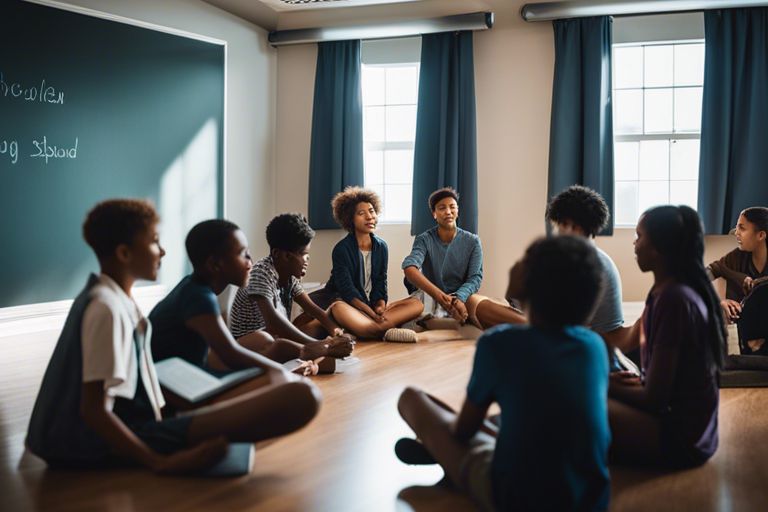
Factors to Consider for Balanced Technology Use
Your middle schooler’s technology use should be approached with careful consideration to ensure a balanced approach to their education and well-being. Here are some important factors to consider:
- Age appropriateness and developmental needs
- The role of technology in the middle school curriculum
- Setting boundaries and clear guidelines
- Monitoring and limiting screen time
Any decision about technology use should take into account your child’s developmental stage, their school curriculum, and the need for clear boundaries and monitoring.
Age Appropriateness and Developmental Needs
When considering technology use, it’s important to take into account your child’s developmental needs and their age-appropriate level of screen time. Middle schoolers are at a stage where they are developing their critical thinking skills, curiosity, and independence. Excessive screen time can impact their social, emotional, and cognitive development.
It’s crucial to strike a balance between technology use and other activities that promote physical activity, social interaction, and creative play in order to support your child’s overall development.
The Role of Technology in the Middle School Curriculum
Technology plays an important role in the middle school curriculum, offering opportunities for interactive learning, research, and collaboration. It can enhance students’ engagement and motivation, and provide access to a wealth of resources and information.
However, excessive reliance on technology can lead to decreased attention span, lack of critical thinking, and potential social and emotional challenges. It’s essential to monitor and moderate your child’s technology use to ensure a balanced approach to their education.
Strategies for Integrating Technology in Learning
To ensure a balanced use of technology in middle school learning, it is important to integrate technology in a way that enhances engagement and allows for effective learning. There are several strategies that you can use to achieve this balance, and the following subsections will discuss some of these strategies in detail.
Enhancing Engagement Through Interactive Tools
Interactive tools can significantly enhance engagement in the learning process. By incorporating tools such as educational games, simulations, and virtual reality experiences into your lessons, you can create a more immersive and interactive learning environment. These tools can make learning more enjoyable and meaningful for students, and can help them retain information more effectively. Additionally, interactive tools can cater to different learning styles, allowing for a more personalized learning experience for each student.
Leveraging Educational Apps and Platforms
Educational apps and platforms offer a wealth of resources and opportunities for learning. By leveraging these tools, you can provide students with access to a wide range of educational content, tailored to their specific learning needs and interests. These apps and platforms can also enable you to track students’ progress and provide personalized feedback, allowing for a more individualized approach to learning. Furthermore, educational apps and platforms can encourage independent learning and self-directed exploration, allowing students to take ownership of their learning.
Tips for Managing Distractions and Maintaining Focus
Keep distractions at bay by establishing a dedicated study area where you can focus on your schoolwork without being interrupted. This could be a quiet corner of your room or a specific area in the house where you feel most productive. Make sure this area is free from electronic gadgets and other potential distractions.
- Turn off notifications on your devices to prevent interruptions while studying.
- Consider using website blockers or apps to limit access to social media and other time-wasting websites during study sessions.
- Take regular breaks to refresh your mind and prevent burnout.
- Use tools like noise-cancelling headphones to block out background noise and help you concentrate.
The key is to create an environment that minimizes distractions and allows you to maintain focus on your learning tasks.
Setting Up a Conducive Learning Environment
Creating a conducive learning environment is essential for optimizing your study and learning experience. Find a space with good lighting, comfortable seating, and minimal distractions. Make sure your study area is organized and free from clutter, allowing you to focus on your assignments and projects without unnecessary distractions.
Establishing Rules and Expectations for Technology Use
When it comes to technology use, it’s important to set clear rules and expectations to ensure that it complements your learning rather than hinders it. Discuss with your parents or guardians about the appropriate use of devices during study time and establish guidelines that help you stay on track with academic responsibilities. It’s essential to find a balance that allows you to benefit from technology while also staying focused on your schoolwork.
Encouraging Responsible Digital Citizenship
Now that you understand the importance of balancing technology use and learning in middle school, it’s crucial to encourage responsible digital citizenship. This entails educating students on online safety, privacy, and positive online behavior.
Teaching Online Safety and Privacy
When it comes to teaching online safety and privacy, it’s important to emphasize the potential dangers of sharing personal information online. You should educate students about the risks of interacting with strangers, the importance of safeguarding their personal information, and the potential consequences of cyberbullying. Encourage them to think critically about the information they share and to be cautious of the websites they visit. It’s also important to teach students how to create strong, unique passwords and the importance of regularly updating them to keep their accounts secure.
Promoting Positive Online Behavior and Etiquette
Promoting positive online behavior and etiquette is essential for creating a respectful and inclusive online environment. You should emphasize the importance of empathy and respect when interacting with others online. Teach students to think before they post or comment, as their digital footprint can have long-lasting consequences. Encourage them to use social media and other online platforms as a force for good, promoting positivity, and using their digital platforms to advocate for causes that are important to them. By promoting a culture of kindness and respect online, you can help create a safer and more pleasant digital space for everyone.
Involving Parents and Guardians
After laying the foundation for a balanced approach to technology use and learning in middle school, it’s essential to involve parents and guardians in the conversation. Your role as a parent or guardian is crucial in shaping your child’s technology use and learning habits. By staying informed and involved, you can help ensure that technology is used in a positive and productive way.
How to Communicate about Technology Use at Home
When it comes to discussing technology use with your child, it’s important to set clear expectations and boundaries. Start by having open and honest conversations about how technology fits into your family’s values and priorities. Encourage your child to share their thoughts and concerns about technology, and listen attentively to their perspective. By creating a safe and non-judgmental space for these conversations, you can better understand your child’s relationship with technology and provide guidance accordingly. Additionally, be proactive in setting guidelines for screen time, device usage, and online behavior to promote a healthy balance between technology and other activities.
Tools for Parental Oversight and Collaboration
As a parent or guardian, there are numerous tools and resources available to help you oversee and collaborate on your child’s technology use. Consider utilizing parental control software to monitor and manage your child’s screen time, app usage, and online activity. These tools can provide insights into your child’s digital behavior and help you address any issues that may arise. Furthermore, establish open lines of communication with your child’s teachers and school administrators to stay informed about the technology used in the classroom and collaborate on fostering a positive learning environment. By working together with educators, you can ensure that technology is integrated into your child’s education in a responsible and beneficial manner.
Monitoring and Adapting the Balance
Unlike with younger children, monitoring and adapting the balance of technology use and learning in middle school takes on an added layer of complexity. Your middle schoolers are likely becoming more independent and taking on more responsibility for managing their own technology use, making it important for you to stay attuned to their habits and needs. It’s crucial to maintain an ongoing assessment of the impact of technology on their learning, as well as to adjust strategies as your students mature and technology evolves.
Ongoing Assessment of Technology’s Impact on Learning
As your middle schoolers engage more deeply with technology, it’s important to regularly assess how it’s affecting their learning. You can use a variety of methods to do this, such as observing your students’ engagement and performance in the classroom, monitoring their use of technology at home, and gathering feedback from both students and parents. Pay attention to any signs of distraction, lack of focus, or decline in academic performance, as these can be indicators that technology is interfering with their learning. Be particularly vigilant of excessive social media use and the presence of cyberbullying, both of which can have a detrimental impact on your students’ well-being and learning.
Adjusting Strategies as Students Mature and Technology Evolves
As your students grow and develop, their relationship with technology will naturally evolve. It’s important for you to adapt your strategies to meet their changing needs. Encourage open communication with your students about their technology use and the challenges they may be facing. Provide them with guidance on how to use technology in a balanced and productive way. Keep pace with the latest technological trends and developments, and consider incorporating new tools and platforms into your teaching to better engage your students. Additionally, be prepared to adjust your approach as technology continues to evolve, ensuring that your methods are always aligned with the best practices for supporting your students’ learning.
Conclusion
Ultimately, finding the right balance between technology use and learning in middle school is crucial for your academic and personal development. It’s important to recognize the benefits of technology in education, but also be mindful of its potential drawbacks. By setting limits on screen time, engaging in hands-on activities, and using technology as a tool rather than a distraction, you can create a healthy balance that promotes both learning and personal growth.
Remember that technology is a tool to enhance your learning experience, not a replacement for traditional methods. By being proactive about managing your tech use and staying engaged in your education, you can create a balanced and successful middle school experience. Striking this balance will not only help you academically, but also foster important skills such as critical thinking, digital literacy, and time management.
FAQ
Q: How can technology use be balanced with learning in middle school?
A: Middle school students can benefit from technology use as long as it is monitored and balanced with other learning activities. It is important for parents and educators to set limits on screen time and encourage a balance of technology use with other learning methods such as reading, hands-on activities, and face-to-face interaction.
Q: What are the risks of excessive technology use in middle school?
A: Excessive technology use in middle school can lead to decreased attention span, reduced physical activity, and negative impacts on social and emotional development. It is important for parents and educators to be aware of these risks and to encourage a healthy balance of technology use with other activities.
Q: How can parents and educators support balanced technology use in middle school?
A: Parents and educators can support balanced technology use by setting clear guidelines and expectations for screen time, providing alternative activities to technology, and modeling healthy technology habits themselves. It is important to have open communication with students about the benefits and risks of technology use, and to emphasize the importance of balance in all aspects of life.
Are you struggling to keep your middle school students focused and engaged in the classroom? It’s no secret that this age group can be easily distracted, making it a challenge for teachers to promote active learning. However, by implementing the right strategies and creating a conducive learning environment, you can encourage active learning and minimize distractions in your middle school classroom. In this blog post, we will discuss effective techniques that you can use to promote engagement and maintain a productive learning environment for your students.
One of the most important factors in encouraging active learning in middle school is creating an engaging curriculum. By incorporating hands-on activities, group discussions, and real-life examples into your lessons, you can capture your students’ attention and encourage interactive learning. Additionally, minimizing distractions in the classroom is crucial. By establishing clear expectations and procedures, and creating a clutter-free and welcoming learning environment, you can help your students stay focused and productive.
Key Takeaways:
- Engage with interactive activities: Incorporate hands-on activities and group work to encourage active participation and critical thinking.
- Implement clear expectations: Establish and communicate clear guidelines for behavior and classroom etiquette to minimize distractions.
- Utilize technology strategically: Integrate technology as a tool for learning, while also setting limits to prevent distractions.
- Provide a supportive learning environment: Foster a positive and inclusive atmosphere that promotes curiosity and collaboration.
- Offer personalized feedback: Provide individualized feedback and encouragement to motivate students and enhance their learning experience.
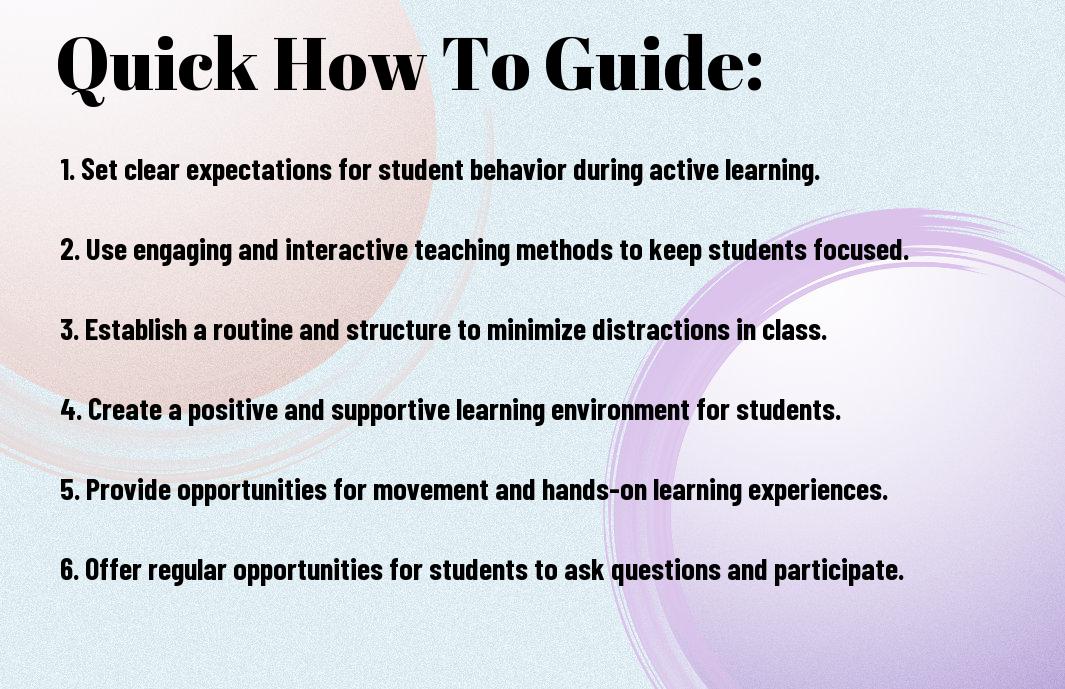
Understanding Active Learning
While traditional learning methods often involve passive listening and memorization, active learning requires you to engage with the material through various activities and discussions. This approach encourages you to think critically, ask questions, and apply what you’ve learned in real-life situations. By actively participating in the learning process, you are more likely to retain information and develop a deeper understanding of the subject matter.
Definition and Key Principles
Active learning can be defined as a hands-on, interactive approach to education that involves you in the learning process rather than just being a passive recipient of information. This method is based on several key principles, including collaboration, problem-solving, and critical thinking. Instead of passively absorbing information, you are encouraged to actively participate in discussions, group activities, and projects that require you to apply your knowledge in practical ways.
Benefits for Middle School Students
Implementing active learning strategies in middle school can have several benefits for you. First, it helps you to stay more engaged and focused during lessons, reducing the likelihood of distractions. Active learning also promotes a deeper understanding of the material by requiring you to analyze and synthesize information rather than simply memorizing facts. Additionally, this approach can enhance your critical thinking skills and problem-solving abilities, preparing you for future academic and real-world challenges.
Identifying Distractions
Your ability to identify and minimize distractions is crucial in creating an environment that fosters active learning in middle school students. By recognizing the different types of distractions students may face, you can better address them and support their focus on the learning material.
Common External Distractions
Common external distractions in a middle school environment may include noise from other classes, hallway traffic, or outside playground activities. These distractions can pull students’ attention away from the lesson and make it difficult for them to concentrate on the material being presented. Additionally, technology, such as smartphones and tablets, can also be a significant source of external distraction for students. It’s important to set clear guidelines for technology use during class time and provide alternative methods for accessing course material.
Internal Distractions and Their Impact
Internal distractions, such as anxiety, stress, or personal issues, can have a significant impact on a student’s ability to focus in the classroom. These distractions can manifest as wandering thoughts, difficulty concentrating, or emotional disturbances, all of which can hinder the learning process. It’s important to create a supportive and inclusive classroom environment where students feel comfortable discussing any personal issues that may be affecting their ability to stay focused. Additionally, teaching mindfulness and stress-reducing techniques can help students manage internal distractions and improve their concentration on the material being taught.
Preparation and Classroom Setup
For an active learning environment in middle school, it is essential to carefully prepare and set up your classroom to minimize distractions and encourage student engagement. The way you arrange the classroom, select furniture and tools, and organize supplies can significantly impact the learning experience for your students.
How to Arrange a Distraction-Minimized Classroom
When setting up your classroom, consider arranging desks or tables in a way that minimizes distractions. Avoid placing desks too close together, as this can lead to students being easily distracted by their peers. Also, ensure that the seating arrangement allows you to easily move around the room and provide individual support to students when needed. Furthermore, make sure to keep the areas around the classroom free from clutter or any unnecessary items that could divert students’ attention.
Selecting Appropriate Furniture and Tools
Choose the right furniture and tools for your classroom to create an environment that is conducive to active learning. Opt for ergonomic and comfortable seating options that promote good posture and allow students to focus on the lesson. Additionally, provide tools and supplies that are appropriate for the age group and subject matter being taught. Consider incorporating interactive whiteboards, visual aids, and other technology to enhance the learning experience and keep students engaged. The arrangement of your furniture and tools can play a crucial role in minimizing distractions and creating an environment that fosters active learning.
How to Encourage Active Learning and Minimize Distractions in Middle School
Teaching Strategies to Foster Active Learning
After setting the foundation for active learning in your middle school classroom, it’s important to incorporate effective teaching strategies that promote student engagement. One proven way to achieve this is by implementing collaborative learning techniques.
Incorporating Collaborative Learning Techniques
Collaborative learning encourages student interaction and engagement in the classroom. By working together on projects, group discussions, or problem-solving activities, students are able to learn from one another and develop important teamwork skills. When students are actively involved in the learning process, they are more likely to stay focused and avoid distractions. Encouraging teamwork and collaboration also creates a sense of community within the classroom, fostering a supportive environment for all students to thrive.
Tips for Individual Engagement in Classroom Activities
To further enhance active learning in your middle school classroom, it’s important to provide opportunities for individual engagement during classroom activities. Incorporating activities that allow for personal reflection and creativity can help students stay focused and make meaningful connections with the material. Some effective strategies for individual engagement include inquiry-based learning activities, independent research projects, and reflective journaling. Encouraging active listening and participation during class discussions also promotes individual engagement and minimizes distractions.
- Encourage teamwork and collaboration
- Provide opportunities for personal reflection and creativity
- Incorporate inquiry-based learning activities and independent research projects
Perceiving the needs of your students and actively involving them in the learning process is key to fostering an environment of active learning and minimizing distractions in your middle school classroom. By implementing effective teaching strategies and creating opportunities for both collaborative and individual engagement, you can empower your students to become active participants in their own education.
Technology and Active Learning
Despite the potential distractions that come with technology, it can be a powerful tool for facilitating active learning in middle school classrooms. When used effectively, technology can enhance engagement, collaboration, and critical thinking skills among students. It is important, however, to strike a balance and ensure that technology integrates seamlessly with the learning experience without causing disruptions.
How to Integrate Technology Effectively
Integrating technology effectively in the middle school classroom starts with choosing the right tools that align with your lesson objectives. Whether it’s utilizing educational apps, interactive presentation tools, or collaborative platforms, make sure that the technology enhances the learning process rather than serving as a mere distraction. Additionally, provide clear guidelines for how technology should be used in the classroom and communicate your expectations to students. Encouraging them to use technology as a research tool, a means of creative expression, or a way to access relevant course materials can help them stay focused and engaged.
Tools and Tips to Minimize Tech Distractions
When integrating technology, it’s important to minimize potential distractions that can divert students’ attention from the learning objectives. Consider utilizing features such as screen monitoring and classroom management software to manage and control students’ access to certain websites and applications. Encourage students to utilize tools such as ad blockers and browser extensions that help minimize distractions during their independent work. Additionally, establish clear guidelines for appropriate tech usage during class and provide support for students who may struggle with managing their digital distractions. Recognizing the potential for distraction and proactively addressing it will help create a more focused and productive learning environment.
Involving Parents and Guardians
Now that you understand the importance of involving parents and guardians in encouraging active learning and minimizing distractions in middle school, let’s discuss some effective strategies to foster a strong home-school partnership.
Communication Strategies to Foster Home-School Partnership
Effective communication is key to building a strong home-school partnership. Regularly keeping parents and guardians informed about their child’s progress, upcoming events, and expectations can help them stay involved and supportive of their child’s learning journey. Utilize various communication channels such as email, newsletters, phone calls, and parent-teacher conferences to keep the lines of communication open. Encourage open and transparent communication, so that parents feel comfortable reaching out with any concerns or questions they may have. Additionally, seek feedback from parents on how they prefer to receive information and adjust your communication strategies accordingly.
How Parents Can Encourage Active Learning at Home
Empowering parents to support their child’s active learning at home is crucial for reinforcing the lessons taught in the classroom. Encourage parents to create a dedicated study space at home where their child can focus on their schoolwork without distractions. Additionally, emphasize the importance of establishing a regular homework routine to help their child develop strong study habits. Encourage parents to participate in educational activities with their child, such as reading together or exploring educational websites and apps. By reinforcing the value of learning at home, parents can further enhance their child’s academic success.
Evaluating Progress and Adjusting Techniques
Unlike passive learning, active learning requires constant evaluation and adjustment to ensure student engagement and minimize distractions. It’s important to regularly assess the progress of your students and make necessary adjustments to your teaching techniques. This will help you keep your students engaged and on track, leading to a more productive learning environment.
Monitoring Student Engagement
One effective way to evaluate progress and adjust your teaching techniques is to consistently monitor student engagement. This involves observing how actively involved students are in the learning process. Are they participating in class discussions? Are they asking questions and seeking clarification when needed? These are all indicators of their level of engagement. You can also use tools such as quizzes, polls, or other interactive activities to gauge their understanding of the material. By regularly monitoring student engagement, you can identify areas where students may need additional support and adjust your approach accordingly.
When and How to Refine Your Approach
Knowing when and how to refine your approach is crucial for encouraging active learning and minimizing distractions in middle school. If you notice that certain students are consistently disengaged or struggling to grasp the material, it may be time to reassess your teaching methods. This could involve incorporating different instructional strategies, breaking down complex concepts into smaller, more digestible chunks, or providing additional resources for struggling students. Additionally, seeking feedback from your students can provide valuable insights into what is and isn’t working in your approach, allowing you to make the necessary adjustments.

Conclusion
Taking this into account, it is important to actively promote and encourage active learning while minimizing distractions in the middle school classroom. By implementing strategies such as incorporating hands-on activities, group discussions, and interactive learning tools, you can engage students and make the learning process more dynamic and enjoyable. Additionally, establishing clear expectations and routines, providing a well-organized and structured learning environment, and effectively communicating with students can help minimize distractions and create a focused and conducive atmosphere for learning.
Remember that your role as an educator is crucial in fostering an environment that is conducive to active learning and minimizing distractions. By implementing these strategies, you can help students develop important critical thinking skills, improve their ability to retain information, and ultimately enhance their overall academic performance.
FAQ
Q: What are some strategies to encourage active learning in middle school?
A: One effective strategy is to incorporate hands-on activities and group work into lessons. This helps to engage students and encourages them to actively participate in their learning. Additionally, providing regular feedback and encouragement to students can motivate them to stay engaged and take ownership of their learning.
Q: How can teachers minimize distractions in a middle school classroom?
A: Creating a structured and organized classroom environment can help minimize distractions. This includes setting clear expectations for behavior and implementing consistent classroom routines. Teachers can also reduce distractions by using technology strategically and creating designated spaces for students to work quietly or collaborate with their peers.
Q: What role do parents and caregivers play in encouraging active learning in middle school?
A: Parents and caregivers can support active learning by providing a positive and supportive home environment. This includes establishing a designated study area for their child, setting aside time for homework and studying, and showing interest in their child’s education. Open communication with teachers and involvement in school activities can also reinforce the importance of active learning at home.
Are you struggling to find ways to keep your middle school students motivated and focused on their academic and personal goals? Setting clear and achievable goals is key to helping your students stay on track and maintain their motivation throughout the school year. In this guide, you will learn effective strategies for setting goals with your students and helping them stay motivated to achieve those goals.
One of the most important aspects of goal setting for middle school students is to make sure the goals are achievable and relevant to their individual abilities and interests. You will also discover the positive impact that setting achievable goals can have on your students’ confidence and overall academic performance. With the guidance and practical tips in this post, you will be equipped to help your middle school students set and achieve their goals while maintaining a high level of motivation.
Key Takeaways:
- Set realistic and specific goals: Help your middle school students create achievable goals by making them specific and attainable. This will prevent them from feeling overwhelmed and keep them motivated.
- Provide support and guidance: Offer your students guidance and support as they work towards their goals. Encourage them to ask questions and seek help when needed.
- Celebrate their progress: Acknowledge and celebrate your students’ progress, no matter how small. This will boost their confidence and keep them motivated to continue working towards their goals.
- Encourage self-reflection: Teach your students to reflect on their progress and identify any obstacles they may be facing. This will help them understand their own strengths and weaknesses, and make necessary changes to stay on track with their goals.
- Promote a positive mindset: Encourage your students to maintain a positive attitude and believe in their ability to achieve their goals. Remind them that setbacks are a natural part of the process and that perseverance is key to success.

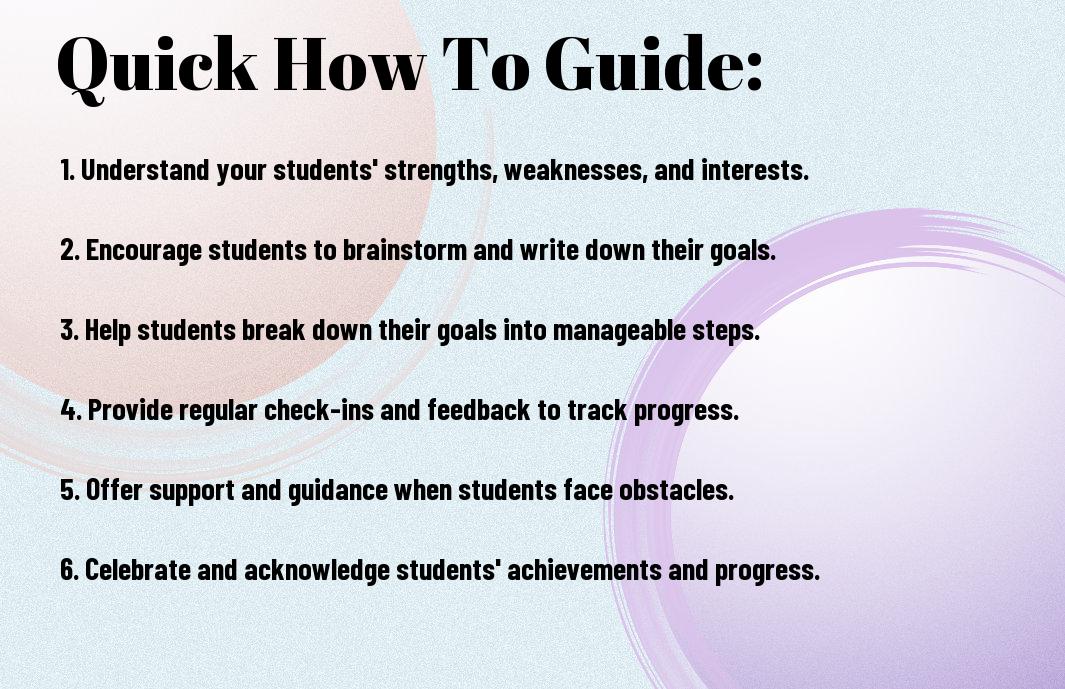
The Psychology Behind Goal Setting and Motivation
Some middle school students may struggle to stay motivated and set achievable goals because they are still developing their understanding of themselves and their capabilities. However, understanding the psychology behind goal setting and motivation can help you as an educator support your students in setting and achieving their goals.
How Goals Influence Student Behavior and Achievement
The act of setting a goal can have a significant impact on a student’s behavior and achievement. When a student sets a specific, measurable goal, it gives them a sense of purpose and direction. This can make them more focused and determined to work towards that goal, leading to improved academic performance and behavior. On the other hand, setting vague or unrealistic goals can have the opposite effect, leading to feelings of frustration and lack of motivation. It’s important to teach your students how to set SMART goals – specific, measurable, achievable, relevant, and time-bound – to ensure they are setting themselves up for success.
The Relationship Between Self-Efficacy and Motivation
Self-efficacy, or the belief in one’s ability to succeed in specific situations, plays a crucial role in a student’s motivation. When students have high self-efficacy, they are more likely to set challenging goals for themselves and put in the effort to achieve them. On the other hand, students with low self-efficacy may avoid setting ambitious goals and may give up more easily when faced with obstacles. As an educator, it’s important to encourage and nurture your students’ self-efficacy by providing them with opportunities to succeed, offering constructive feedback, and helping them develop a growth mindset.
Laying the Foundation for Effective Goal Setting
Keep in mind that effective goal setting begins with creating a foundation that encourages your middle school students to take charge of their own learning and personal growth. By laying the groundwork for setting achievable goals, you can help your students stay motivated and focused on the path to success.
Tips for Involving Students in the Process
When it comes to goal setting, involving your students in the process is crucial for their success. Encourage active participation and engagement by:
- Encouraging students to reflect on their strengths, weaknesses, and areas for improvement
- Empowering students to identify their own goals, as opposed to setting goals for them
- Facilitating open discussions to help students articulate their aspirations and ambitions
Any time students take an active role in setting their own goals, they are more likely to feel invested in the process and dedicated to achieving their objectives.
Factors to Consider When Helping Students Define Their Goals
When helping students define their goals, it’s important to consider certain factors that can positively impact their ability to set and achieve realistic goals. Take into account the following:
- The individual strengths and weaknesses of each student
- The level of motivation and commitment demonstrated by each student
- The relevance and significance of the goals within the student’s personal context
Though achieving success in goal-setting can be challenging, your guidance and support will play a fundamental role in steering your students toward their objectives.
How-To Create SMART Goals with Students
After introducing the concept of setting achievable goals to your middle school students, the next step is to guide them through creating SMART goals. SMART stands for Specific, Measurable, Achievable, Relevant, and Time-Bound. By following this framework, you can help students set goals that are clear, attainable, and aligned with their aspirations.
Specific: Defining Clear and Precise Objectives
When setting goals with your middle school students, it’s important to define specific and clear objectives. Encourage them to identify what exactly they want to achieve and to articulate their goals in detail. Clarity is key in this step, as vague or general goals can be difficult to work towards and measure progress against. For example, instead of setting a goal to “improve in math,” encourage your students to specify their target, such as “improve my math grade from a C to a B by the end of the semester”.
Moreover, ensure that the goals are personalized to each student’s interests and needs. By having a specific target in mind, students can better focus their efforts and stay motivated throughout the process.
Measurable: Establishing Criteria for Success
Once the specific objectives are defined, the next step is to establish measurable criteria for success. This means identifying the indicators that will demonstrate progress and achievement. By establishing measurable benchmarks, students can track their advancement and adjust their efforts accordingly.
Measurable goals also provide a sense of accountability as students have tangible metrics to strive for. This can help them stay on track and remain motivated, knowing that their progress is being monitored and measured based on clear criteria.
Achievable: Setting Realistic and Attainable Goals
It’s important to ensure that the goals set by your middle school students are realistic and attainable. While it’s essential to encourage ambition, setting goals that are too far out of reach can lead to frustration and demotivation. Realistic goals take into account the student’s abilities, resources, and available support.
By setting achievable goals, students can experience the satisfaction of making progress and reaching milestones, which in turn can boost their confidence and motivation to pursue future goals.
Relevant: Ensuring Goals Align with Students’ Interests and Aspirations
When working with middle school students to set goals, it’s crucial to ensure that the objectives are relevant to their interests and aspirations. Alignment with their personal passions and long-term aspirations makes the goals more meaningful and compelling.
Help your students understand the relevance of their goals to their overall growth and development. By connecting their goals to their broader aspirations and interests, you can fuel their intrinsic motivation to work towards and achieve their objectives.
Time-Bound: Creating a Sense of Urgency and a Timeline
Lastly, incorporating a time-bound element into the goal-setting process is crucial to create a sense of urgency and establish a clear timeline for achievement. Encourage your students to set specific deadlines or milestones to reach their goals, which can help them stay focused and motivated.
A clear timeline also provides a sense of structure and urgency, preventing procrastination and keeping students accountable for their progress. Additionally, it allows them to break down their goals into manageable tasks and track their advancement over time.
Strategies for Maintaining Student Motivation
Now that you have set achievable goals for your middle school students, it’s important to consider strategies for keeping them motivated throughout the process. Here are some effective techniques to maintain their motivation and help them stay focused on reaching their goals.
The Role of Rewards and Recognition
One way to keep your students motivated is by implementing a rewards and recognition system. When students know that their hard work will be acknowledged and rewarded, they are more likely to stay motivated and focused on their goals. Consider implementing a points-based system where students earn points for completing tasks, exhibiting good behavior, or achieving milestones. These points can then be redeemed for rewards, such as extra recess time, a special privilege, or a small prize. Additionally, publicly recognizing students’ accomplishments in front of their peers can also boost their motivation and inspire them to continue striving for success.
Tips for Providing Constructive Feedback
Another crucial factor in maintaining student motivation is providing constructive feedback. When students receive feedback that is specific, actionable, and focused on improvement, they are more likely to stay on track and continue working towards their goals. Make sure to provide feedback that is balanced, acknowledging both their strengths and areas for improvement. This will help them feel motivated to build on their strengths while also addressing areas that need improvement. Additionally, providing feedback in a timely manner allows students to make immediate adjustments and see the impact of their efforts. When offering feedback, be sure to use positive language and encourage their progress. Provide specific examples of what they did well and where they can improve, and offer guidance on how they can make the necessary changes. Perceiving feedback as constructive rather than critical will help students maintain their motivation and continue striving towards their goals.
Incorporating Motivational Factors into Everyday Learning
For middle school students, motivation is key to achieving academic success. Here are some tips to help you incorporate motivational factors into everyday learning:
- Provide clear goals and objectives for each lesson
- Use positive reinforcement to reward student achievements
- Allow for autonomy and choice in learning activities
- Encourage a growth mindset in your students
Perceiving learning as an opportunity for growth and personal development can significantly impact a student’s motivation and ultimately their success in school.
Enhancing Autonomy and Choice in Learning Activities
When students feel a sense of control over their learning, they are more likely to be engaged and motivated. Providing opportunities for autonomy and choice in learning activities can empower middle school students to take charge of their education. You can achieve this by allowing students to select topics for projects, giving them some flexibility in how they complete assignments, and providing options for demonstrating their understanding of the material. By offering autonomy and choice, you are fostering a sense of ownership and responsibility in your students, which can lead to increased motivation and performance.
How to Foster a Growth Mindset in Students
Encouraging a growth mindset in your middle school students can have a significant impact on their motivation and resilience in the face of academic challenges. Emphasize the idea that abilities and intelligence can be developed through hard work, good strategies, and input from others. Help students understand that setbacks and obstacles are a natural part of the learning process and that they can be opportunities for growth. By praising effort and persistence rather than just intelligence, you can promote a positive attitude towards learning and increase students’ willingness to take on new challenges. By fostering a growth mindset, you can help your students build the resilience and determination needed to succeed in school and beyond.
How to Handle Setbacks and Foster Resilience
Not every goal will be achieved smoothly, and setbacks are a natural part of any journey. As a middle school educator, it’s important to equip your students with the tools to handle setbacks and foster resilience. Teaching them how to overcome obstacles and encouraging perseverance and grit will help them stay motivated and work towards their goals.
Teaching Students to Overcome Obstacles
One of the most valuable lessons you can teach your middle school students is how to overcome obstacles. Show them that setbacks are not a reason to give up, but an opportunity to learn and grow. Help them develop problem-solving skills and a positive mindset to tackle challenges head-on. Encourage them to seek help when needed and to view setbacks as temporary roadblocks rather than insurmountable barriers.
Tips for Encouraging Perseverance and Grit
When it comes to fostering perseverance and grit in your middle school students, there are a few key strategies you can implement. First and foremost, lead by example. Show them how you handle setbacks and demonstrate resilience in your own actions. Encourage a growth mindset by praising efforts and progress rather than innate abilities. Create a supportive and inclusive classroom environment where students feel safe to take risks and learn from their mistakes. Additionally, provide regular feedback and guidance to help students develop their skills and grow.
- Set clear, achievable goals – Break down larger goals into smaller, manageable tasks and celebrate progress along the way.
- Emphasize the value of effort – Encourage the belief that hard work and determination lead to success.
- Offer support and resources – Provide access to extra help, mentorship, and tools to help students overcome challenges.
Though setbacks are inevitable, by teaching your middle school students how to handle them and fostering resilience, you are helping them build the necessary skills and mindset to stay motivated and achieve their goals. Remember, setbacks are not failures, but opportunities for growth and learning.
Conclusion
From above, you now have a clearer understanding of how to set achievable goals for your middle school students and help them stay motivated. Remember to encourage them to break down their goals into smaller, manageable tasks, and to celebrate their progress along the way. By regularly checking in with them and providing support, you can keep them on track and help them build the confidence needed to achieve their goals.
By implementing the strategies discussed, you can create a positive and motivating environment for your students, ultimately leading to increased productivity and a sense of accomplishment. Your guidance and support can make a significant impact on your students’ ability to set and achieve goals, setting them up for success not only in their middle school years, but also in their future endeavors. Keep in mind that each student is unique, so be sure to tailor your approach to their individual needs and strengths. With your dedication and guidance, your students will thrive and become more self-motivated individuals.
FAQ
Q: Why is it important to set achievable goals for middle school students?
A: Setting achievable goals helps middle school students stay motivated by giving them a clear direction and purpose. It teaches them valuable skills in time management, self-discipline, and perseverance, which are essential for their academic and personal development. Additionally, achieving small, realistic goals boosts their confidence and self-esteem, making them more likely to take on bigger challenges.
Q: What are some strategies for setting achievable goals for middle school students?
A: One strategy is to break down big goals into smaller, more manageable tasks. This makes the goals less intimidating and easier for students to grasp. Another strategy is to make the goals specific, measurable, attainable, relevant, and time-bound (SMART). This helps students clarify exactly what they want to accomplish and how they will do it. Additionally, it’s important to involve students in the goal-setting process and encourage them to take ownership of their goals, ensuring they are personally invested in achieving them.
Q: How can teachers and parents help middle school students stay motivated to reach their goals?
A: Teachers and parents can provide support and encouragement by offering praise, constructive feedback, and guidance. They can also help students stay focused and on track by regularly checking in on their progress and offering assistance when needed. Creating a positive and nurturing environment that celebrates the effort and progress, rather than just the end result, will also help students stay motivated. Lastly, leading by example and demonstrating a strong work ethic and resilience will inspire students to stay motivated and determined to achieve their goals.
Have you ever found yourself struggling to stay motivated in your middle school studies? It’s important to recognize that external factors can play a significant role in your level of motivation and academic performance. In order to excel in your learning journey, it’s crucial to identify and overcome these external factors that may be impacting your motivation.
External factors such as peer pressure, family dynamics, and environmental stressors can all influence your ability to stay motivated and focused on your studies. By understanding and addressing these factors, you can take control of your own motivation and create a more positive and productive learning environment. In this blog post, we’ll explore various strategies and techniques to help you identify and overcome these external factors, ultimately empowering you to achieve your full potential in middle school. Stay tuned for actionable tips and advice to help you navigate and conquer the challenges that may be hindering your motivation.
Key Takeaways:
- External factors such as family issues, peer pressure, and social media can significantly impact middle school students’ motivation to learn. It is important to recognize and address these factors in order to support student learning.
- Teachers and parents should communicate regularly to identify potential external factors that may be affecting a student’s motivation. Creating a strong support network can help address these issues more effectively.
- Implementing strategies such as goal-setting and positive reinforcement can help motivate middle school students and counteract external factors that may be impacting their learning.
- It is crucial to encourage a positive and nurturing environment both at home and in the classroom to counteract the negative effects of external factors on motivation.
- Building resilience and teaching students to persevere in the face of external challenges is essential to help them overcome and combat external factors impacting their motivation in middle school learning.
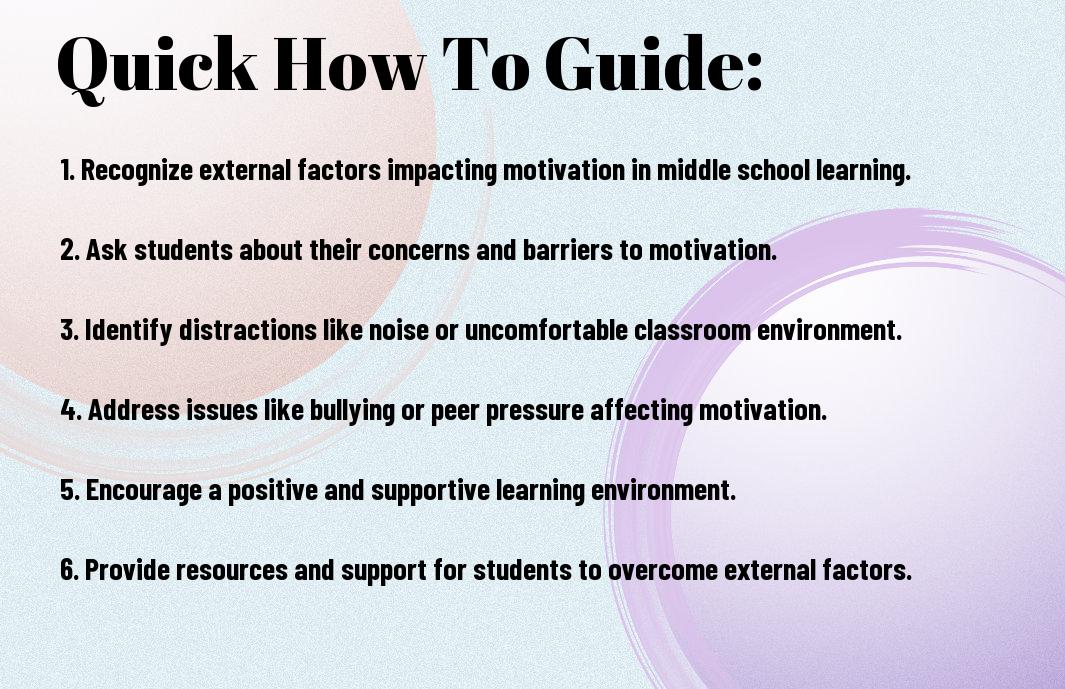
Identifying Key External Factors
Clearly, there are a multitude of external factors that can impact your motivation in middle school learning. It’s important to recognize and address these factors in order to overcome any obstacles that may be hindering your academic success. After identifying the key external factors, you can devise strategies to navigate through them and stay motivated in your learning journey.
Analyzing Home Environment Influences
Your home environment can play a significant role in shaping your motivation and attitude towards school. Factors such as family dynamics, parental expectations, and the availability of a conducive study space can all impact your academic performance. Additionally, the level of support and encouragement you receive at home can greatly influence your motivation to excel in your studies. Understanding these influences can help you address any barriers and create a more supportive home environment for your learning.
Assessing the Impact of Peer Relationships
Peer relationships can have a significant impact on your motivation and engagement in school. Your friends and classmates can either inspire and support you or deter you from reaching your full potential. It’s important to assess the influence of peer relationships on your academic performance and identify any negative influences that may be affecting your motivation. By surrounding yourself with positive and supportive individuals, you can enhance your motivation and success in school.
The Role of School Climate and Culture
The school environment plays a crucial role in shaping your motivation and emotional well-being. The overall climate and culture of the school, including the level of support from teachers, the presence of bullying, and the availability of extracurricular activities, can all impact your academic engagement. Recognizing the influence of the school environment on your motivation can help you navigate any challenges and actively seek out resources to enhance your learning experience.
Media and Technology as External Stimuli
Media and technology can serve as both positive and negative external stimuli that may impact your motivation in middle school learning. The excessive use of social media, video games, and other digital distractions can hinder your academic performance and motivation. On the other hand, technology can also be used as a tool for learning and education. It’s important to recognize the influence of media and technology on your motivation and develop strategies to manage their impact on your academic engagement.
Societal and Cultural Expectations
Societal and cultural expectations can significantly influence your motivation and attitude towards learning. The pressure to conform to certain standards and expectations can create barriers to your academic success. It’s important to recognize the influence of societal and cultural expectations on your motivation and take proactive steps to develop a positive mindset and outlook towards learning. By understanding and addressing these external factors, you can cultivate a sense of autonomy and direction in your educational journey.
How-To Guide: Tools and Strategies for Teachers
Unlike internal factors that may impact a student’s motivation, external factors are often beyond their control. As a middle school educator, it is crucial for you to identify these external factors and implement strategies to help students overcome them. Here are some tools and strategies to help you support and motivate your students in their learning journey.
Developing a Supportive Classroom Environment
Creating a supportive classroom environment is essential for fostering motivation in middle school students. As a teacher, you can accomplish this by building strong relationships with your students, getting to know them on a personal level, and showing a genuine interest in their well-being. Additionally, creating a safe and inclusive space where every student feels valued and respected can go a long way in boosting their motivation to learn.
Tips for Enhancing Student Engagement
Enhancing student engagement is key to maintaining their motivation in the classroom. To achieve this, you can incorporate a variety of teaching strategies such as hands-on activities, group discussions, and interactive learning experiences. Additionally, integrating technology into your lessons can help capture students’ interest and keep them actively involved in the learning process. This can include using educational apps, online resources, or interactive presentations to make the learning experience more dynamic and interactive. This active engagement can significantly improve their motivation levels and overall performance. This is crucial for a positive learning experience, and it can make a big impact on their motivation to learn.
Individualized Learning Plans and Their Benefits
Individualized learning plans can help address the diverse needs of middle school students and support their individual learning styles. By tailoring lessons and assignments to their specific strengths, weaknesses, and interests, you can improve their motivation and performance. This approach acknowledges that every student has unique abilities and challenges, and providing personalized support can make a significant difference in their motivation and success.
Ensuring Consistent Communication with Parents
Consistent communication with parents is vital for supporting students’ motivation in their learning journey. By keeping parents informed about their child’s progress, behavior, and any challenges they may be facing, you can enlist their support in motivating their children at home. Additionally, involving parents in school activities and decision-making processes can create a collaborative support system for the students, further bolstering their motivation and success.
Fostering Peer Support and Collaboration
Fostering peer support and collaboration can significantly impact students’ motivation in middle school. Encouraging teamwork, group projects, and peer tutoring can create a sense of community and cooperation among students. This can boost their confidence, enhance their social skills, and provide a supportive network for them to rely on. Furthermore, peer support can help alleviate feelings of isolation and anxiety, which can hinder a student’s motivation. Cultivating a positive and collaborative classroom environment can foster a sense of belonging and motivation among your students.

How-To Guide: Involving Parents and Guardians
For middle school students, involving parents and guardians in their learning journey can have a significant impact on their motivation and academic success. By working together, you can create a supportive and enriching environment that encourages and nurtures your child’s love for learning. Here are some effective strategies to involve parents and guardians in supporting and enhancing your child’s motivation in middle school.
Effective Parent-Teacher Partnerships
One of the most powerful ways to support your middle schooler’s motivation is by establishing a strong partnership with their teachers. When you and your child’s teachers are on the same page and communicate regularly, it can create a unified front that reinforces your child’s learning experience. This can be achieved through attending parent-teacher conferences, actively participating in school events, and maintaining open lines of communication through email or phone calls. By working together, you can ensure that your child’s educational needs are addressed, leading to a more motivated and engaged learner.
Strategies for Home Reinforcement of Motivation
At home, you can reinforce and boost your child’s motivation by creating a conducive environment for learning. This can include establishing a dedicated study space, setting a consistent routine for homework and study time, and providing the necessary resources, such as books and educational materials. Additionally, you can encourage and celebrate your child’s achievements, which can significantly boost their confidence and motivation. By creating a supportive and nurturing home environment, you empower your child to approach their studies with a positive and motivated mindset.
Managing Screen Time and Digital Distractions
In today’s digital age, managing screen time and digital distractions is crucial for maintaining your child’s motivation in their studies. Excessive screen time and unfettered access to digital devices can lead to distractions and a lack of focus, impeding your child’s ability to stay motivated. By setting clear boundaries and limits on screen time, you can help your child develop self-discipline and focus on their academic responsibilities. Encourage alternative activities, such as reading, physical exercise, or creative hobbies, to provide a healthy balance and mitigate the negative impact of excessive screen time on your child’s motivation and overall well-being.
How-To Guide: Student-Centered Approaches
To create a student-centered approach in middle school learning, you need to focus on cultivating a growth mindset among students, encouraging student autonomy and choice, and implementing recognition and rewards for positive reinforcement. By employing these strategies, you can empower students to take ownership of their learning and boost their motivation.
Cultivating a Growth Mindset Among Students
One of the most effective ways to foster a growth mindset among middle school students is to emphasize the power of yet. Encourage them to understand that they may not have mastered a concept or skill yet, but with effort and perseverance, they can improve and grow.
Additionally, praise effort and progress rather than focusing solely on achievements. By reinforcing the idea that hard work and dedication lead to success, students are more likely to embrace challenges and view mistakes as opportunities for learning.
Encouraging Student Autonomy and Choice
Empowering students to make choices in their learning process can have a significant impact on their motivation. Providing options for how they demonstrate their understanding of a concept or allowing them to select topics for projects can increase their engagement and enthusiasm for learning.
Encourage students to set personal goals and take ownership of their learning journey. By doing so, they will develop a sense of responsibility and become more invested in their educational experience.
Recognition and Rewards: Tips for Positive Reinforcement
Implementing a system of positive reinforcement through recognition and rewards can further enhance motivation in middle school learning. Acknowledge and celebrate both individual and group achievements, and consider implementing a reward system that recognizes students’ efforts and accomplishments.
- Provide verbal praise and encouragement to acknowledge students’ progress and efforts.
- Consider using a rewards system, such as a point-based system with incentives for reaching certain milestones or demonstrating consistent effort.
- Offer tangible rewards, such as certificates, tokens, or small prizes, to reinforce positive behavior and academic achievement.
After implementing these strategies, you will notice a positive shift in the classroom culture as students become more motivated and engaged in their learning.
Overcoming Specific Challenges
Despite the external factors impacting motivation in middle school learning, it is important to address and overcome specific challenges to ensure that students remain motivated and engaged in their academic journey. It is important to recognize and understand the diverse needs of students, tackle academic pressure and stress, confront bullying and social anxieties, and ensure that resources and supports are available for students with learning disabilities.
Addressing the Diverse Needs of Students
When it comes to addressing the diverse needs of students in a middle school setting, it is essential to create an inclusive and supportive learning environment. This means acknowledging and respecting the individual differences and abilities of each student. By adapting teaching methods, providing personalized support, and promoting a sense of belonging, you can help students feel valued and motivated to actively engage in their learning.
Tackling Academic Pressure and Stress
Academic pressure and stress can significantly impact a middle school student’s motivation. It is essential to create a balanced approach to learning and academics, ensuring that students do not feel overwhelmed or overburdened by their studies. Encourage time management and stress-relief techniques, and remind students that it is okay to ask for help. By creating a supportive and understanding environment, you can help students manage their academic pressures effectively.
Confronting Bullying and Social Anxieties
Bullying and social anxieties are serious challenges that can greatly impact a student’s motivation and overall well-being. It is crucial to address and confront these issues head-on by fostering a culture of respect, empathy, and open communication. Encourage students to speak up, seek help from trusted adults, and promote kindness and inclusivity within the school community to combat bullying and social anxieties.
Resources and Supports for Students with Learning Disabilities
For students with learning disabilities, having access to appropriate resources and supports is crucial for maintaining motivation and achieving academic success. Ensure that individualized education plans (IEPs) are implemented effectively, offer additional support through special education programs, and provide assistive technologies to help students overcome their learning challenges. By acknowledging and catering to the specific needs of these students, you can help them thrive in their academic journey.
Sure, here is the content for the chapter on Measurement and Adjustment:
Measurement and Adjustment
Now that you have identified the external factors impacting motivation in middle school learning, it’s important to measure the impact and make necessary adjustments to address any negative influences. Measurement and adjustment is crucial to maintaining a positive and motivating learning environment for your students.
Monitoring Student Progress and Motivation
Monitoring your students’ progress and motivation levels is essential to understanding how external factors are impacting their learning experience. Regularly assess their engagement, participation, and overall performance. Keep an eye on any changes in behavior or attitude towards learning, as these can be indicators of external factors affecting their motivation.
How-To Utilize Feedback for Continuous Improvement
Feedback from students, parents, and other educators can provide valuable insights into the external factors that are impacting motivation in middle school learning. Actively seek feedback and use it to continuously improve your teaching methods and the learning environment. Adjust your strategies based on the feedback received to address any external factors negatively impacting motivation.
Adapting Strategies to Ever-Changing External Factors
Adapting your teaching strategies to address ever-changing external factors is crucial in maintaining a positive and motivating learning environment. Some strategies include flexible lesson planning, incorporating diverse teaching methods, and creating a supportive classroom culture. Emphasize the importance of resilience and adaptability in the face of adversity. Adapt your teaching approach to accommodate different learning styles and individual needs. Remember, the educational landscape is constantly evolving, and so should your approach to teaching.
- Flexible lesson planning
- Incorporating diverse teaching methods
- Creating a supportive classroom culture
Though external factors may continue to evolve, your ability to adapt and address them will ensure a positive and motivating learning experience for your middle school students.
Conclusion
Following this guide, you should now have a better understanding of the external factors that can impact motivation in middle school learning. You have learned how to identify these factors, such as home environment, peer influence, and school culture, and have gained insight into how they can affect your motivation to learn. By recognizing these external influences, you can take proactive steps to overcome them and maintain your motivation in your academic pursuits.
Remember that you have the power to control your response to external factors and to adopt strategies that will help you stay motivated. Whether it’s creating a positive study environment at home, surrounding yourself with supportive friends, or seeking out additional resources and support at school, there are various ways to mitigate the impact of external factors on your motivation to learn. With perseverance and the right mindset, you can overcome these challenges and continue to thrive in your middle school education.
FAQ
Q: What are external factors that impact motivation in middle school learning?
A: External factors that can impact motivation in middle school learning include peer pressure, family dynamics, socioeconomic status, and the school environment.
Q: How can we identify external factors impacting motivation in middle school learning?
A: To identify external factors impacting motivation in middle school learning, it is important to observe changes in behavior, academic performance, and interaction with peers. Conducting surveys or interviews with students and their parents can also provide valuable insights.
Q: What are some strategies to overcome external factors impacting motivation in middle school learning?
A: Strategies to overcome external factors impacting motivation in middle school learning include creating a supportive and inclusive school environment, providing counseling and mentorship programs, offering extracurricular activities, and promoting a growth mindset in students. Additionally, involving parents and guardians in the educational process can help address external factors and provide necessary support for students.
Do you find middle school students struggling to manage distractions and improve focus in class? It’s no surprise that maintaining concentration in a classroom full of distractions can be challenging for adolescents. However, there are effective strategies you can implement to help your students stay on task and engaged during lessons.
Establishing clear expectations and routines in the classroom is key to helping students manage distractions and improve focus. By setting clear guidelines for behavior and participation, you provide a structured environment that supports their learning. Additionally, creating a designated workspace for each student can help minimize distractions and promote concentration. Furthermore, incorporating active learning techniques and varied teaching methods can help keep students engaged and focused on the lesson. By implementing these strategies, you can help your middle school students optimize their learning experience and succeed academically.
Key Takeaways:
- Establish Clear Expectations: Set clear guidelines and expectations for behavior and focus in the classroom to help students understand what is required of them.
- Teach Time Management Skills: Help middle school students develop time management skills to better prioritize tasks and manage their time effectively.
- Provide a Structured Environment: Create a structured learning environment with minimal distractions to help students stay focused and on task.
- Use Visual Aids and Technology Wisely: Incorporate visual aids and technology into lessons in a way that enhances learning and minimizes distractions.
- Encourage Mindfulness and Self-Regulation: Teach students techniques for staying present and managing their own distractions through mindfulness and self-regulation strategies.
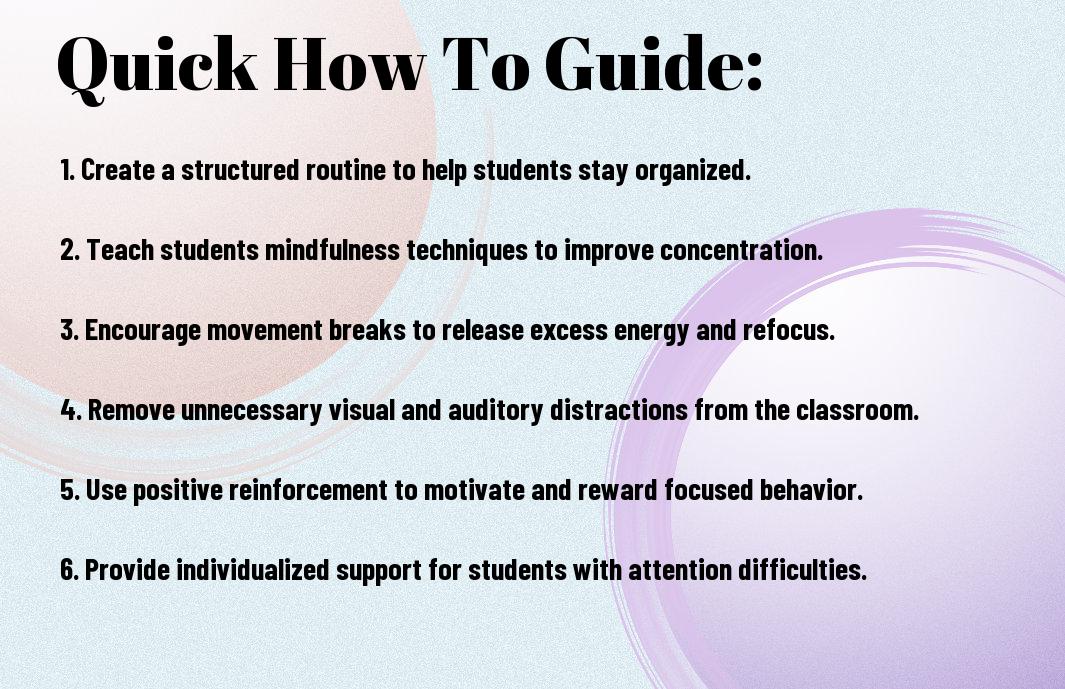
Factors Contributing to Distractions
One of the key factors contributing to distractions for middle school students is the environment in which they are learning. This can include noisy classrooms, cluttered workspaces, and even the layout of the classroom itself. Another factor is the ever-present lure of digital devices, which can lead to constant notifications and temptations to check social media or play games. Additionally, personal factors such as fatigue, hunger, or stress can also play a significant role in distracting students. This combination of internal and external distractions can make it difficult for students to maintain focus and engage effectively in their learning.
- Noisy classrooms
- Cluttered workspaces
- Digital devices
- Fatigue, hunger, or stress
This can significantly impact their ability to succeed academically and can contribute to a lack of engagement in the classroom.
External Distractions and Their Impact
External distractions such as noise, visual stimuli, and interruptions from classmates can have a significant impact on a student’s ability to focus in class. These distractions can make it difficult for you to concentrate on the lesson being taught, leading to reduced learning outcomes and engagement. Additionally, the constant lure of digital devices and social media notifications can pull you away from the task at hand, making it challenging to maintain focus on classroom activities.
Internal Distractions and Student Focus
Internal distractions, such as feelings of stress, hunger, or fatigue, can also have a significant impact on your ability to focus in class. These factors can affect your cognitive abilities and make it challenging to concentrate, engage, and participate in classroom activities. Additionally, personal thoughts and worries may also distract you from the lesson, making it difficult to absorb and retain the information being presented.
It’s essential to recognize the impact of both internal and external distractions on your ability to focus in class and take proactive steps to minimize their influence on your learning experience.

Strategies for Managing External Distractions
For middle school students, managing external distractions is essential for improving focus in the classroom. Here are some strategies to help you minimize external distractions and create an optimal learning environment.
Creating an Optimal Learning Environment
Creating an optimal learning environment is crucial for minimizing external distractions. Make sure your classroom is organized and free from clutter. Clear and organized spaces can help you focus better and reduce the potential for distractions. Additionally, proper lighting and comfortable seating can also play a significant role in improving your ability to concentrate in class. By creating a comfortable and conducive environment, you can better manage external distractions and stay focused on your studies.
Setting Boundaries with Technology
In today’s digital age, technology can be a significant source of distraction for middle school students. In order to manage external distractions, it’s important to set boundaries with technology. Establishing specific times for technology use and designating tech-free zones can help you minimize distractions and stay focused during class. Additionally, implementing rules for phone usage and encouraging the use of technology for educational purposes only can also help you stay on track and improve your focus during school hours.
Approaches to Internal Distractions
Not all distractions in the classroom are external. Sometimes, students may struggle with internal distractions that hinder their ability to focus on the task at hand. It’s important to address these internal distractions and provide students with tools to help them manage their thoughts and emotions.
Mindfulness and Focus Techniques
One approach to managing internal distractions is to teach students mindfulness and focus techniques. By practicing mindfulness, you can train your mind to stay present and focused on the task at hand. Encourage students to take a few moments each day to practice deep breathing or meditation, which can help them clear their minds and improve their ability to concentrate. Additionally, introducing simple focus exercises, such as visualizations or guided imagery, can help students develop their concentration skills and reduce internal distractions.
Addressing Personal and Emotional Distractions
Addressing personal and emotional distractions is another important aspect of helping middle school students manage their focus in class. Encourage students to reflect on their emotions and identify any personal issues that may be affecting their ability to concentrate. By acknowledging and addressing their emotions, students can better manage their personal distractions and improve their focus in the classroom. Additionally, fostering a supportive and empathetic classroom environment can help students feel comfortable sharing their feelings and seeking assistance when needed.
It’s also important to educate students about the impact of personal and emotional distractions on their academic performance. Help them understand that ignoring these distractions can have long-term negative effects on their learning and overall well-being. Encourage them to seek help from a trusted adult or counselor if they are struggling with personal or emotional distractions that are impacting their focus in class.
Involving Parents and Caregivers
Keep communication open with parents and caregivers to ensure that they are aware of the strategies being implemented in the classroom to help their child manage distractions and improve focus. Encourage them to reinforce these strategies at home to provide a consistent environment for the student.
Communication Strategies for Home and School
When it comes to communication between home and school, it’s important to establish a clear line of dialogue. Keep parents informed about what is happening in the classroom, and ask for their input on how they can support their child’s focus. Discuss the specific distractions you are targeting in class and ask the parents if they are present at home as well. This way, you can work together to create a consistent approach to managing distractions. Additionally, be open to feedback from parents about what strategies are working at home, and adjust your approach accordingly.
At-Home Practices to Support Focus
Encourage parents and caregivers to create a dedicated study space at home where distractions are minimized. This space should be quiet, well-lit, and free from electronic devices or other potential interruptions. Additionally, establishing a consistent daily routine can help middle school students stay focused. This routine should include designated study times and breaks, as well as a consistent bedtime. Encouraging physical activity and healthy eating habits can also contribute to improved focus at home. And finally, limit screen time and set clear boundaries around the use of electronic devices.
Collaborating with Students
After recognizing the importance of involving middle school students in managing distractions and improving focus, you can start by collaborating with them. By working together, you can gain a better understanding of their needs and challenges, and tailor solutions that are more effective and sustainable. Here are some ways to collaborate with your students in addressing these issues.
Involving Students in Solution-Seeking
When it comes to managing distractions and improving focus, involving students in seeking solutions can be highly beneficial. Encourage them to share their thoughts and ideas on what strategies could work best for them. Giving them a voice in the process can increase their sense of ownership over the solutions, making them more likely to actively participate and adhere to the agreed-upon strategies. You can hold group discussions or use anonymous suggestion boxes to gather their input. By involving them in the solution-seeking process, you demonstrate that you value their perspective and are committed to finding solutions that work for everyone.
Individual and Group Goal Setting
Another effective way to collaborate with middle school students is by involving them in individual and group goal setting. Encourage your students to set specific, achievable goals for managing distractions and improving focus. These goals could range from reducing screen time to utilizing specific focus techniques. By setting goals, students can take ownership of their progress and work towards measurable outcomes. Additionally, you can facilitate group goal setting sessions where students collectively establish guidelines for minimizing distractions in the classroom. This not only fosters accountability but also creates a supportive environment where everyone is working towards a common objective.
By involving your students in the solution-seeking process and empowering them to set individual and group goals, you are fostering a collaborative approach to managing distractions and improving focus. Your students will feel more engaged, empowered, and committed to making positive changes. It’s important to remember that the success of these strategies will depend on your ongoing support and encouragement. Keep the lines of communication open and regularly check in with your students to assess their progress and make any necessary adjustments. Remember, collaboration is key to finding effective solutions together.
Leveraging Educational Technology
Unlike traditional classroom methods, leveraging educational technology can help middle school students manage distractions and improve focus in class. With the right tools and strategies, you can create an environment that promotes engagement and learning, while minimizing disruptions.
Tools to Enhance Focus and Learning
There are various educational technology tools that can help enhance focus and learning in the classroom. For example, interactive whiteboards and educational apps can make lessons more engaging and interactive, capturing your attention and helping you stay focused. Additionally, tools such as noise-cancelling headphones or ambient background music can create a conducive environment for learning, minimizing distractions and helping you concentrate on the task at hand. These tools can also help cater to different learning styles and preferences, making the learning experience more personalized and effective.
Limiting Counterproductive Tech Usage
While educational technology can be beneficial, it’s important to be mindful of counterproductive tech usage that can hinder focus and productivity. For example, excessive use of social media, gaming, or non-educational websites during class time can be major distractions. It’s important to set boundaries and guidelines for tech usage in the classroom to ensure that it’s being used for educational purposes. Encouraging students to use technology responsibly and emphasizing the importance of staying focused during class can help mitigate distractions and improve overall learning outcomes.
Professional Development for Educators
To help middle school students manage distractions and improve focus in class, it is important for educators to undergo professional development that equips them with the necessary tools and knowledge to address these issues effectively. By staying informed about the latest research and best practices, educators can create a learning environment that fosters focus and minimizes distractions for their students.
Training on Focus and Distraction Management
Professional development opportunities that focus on training educators in focus and distraction management are essential for equipping teachers with the skills they need to help their students stay on task. Workshops and seminars can provide valuable insights and practical strategies that educators can implement in the classroom to promote better focus and minimize distractions. These training sessions can cover topics such as effective classroom management techniques, incorporating mindfulness practices, and leveraging technology for educational purposes while minimizing its potential for distraction.
Keeping Up-to-date with Research
Staying informed about the latest research on attention and focus is crucial for educators as it allows them to incorporate evidence-based practices into their teaching. Professional development opportunities that focus on keeping up-to-date with research can provide educators with access to the latest findings in cognitive psychology, educational technology, and classroom management strategies. By integrating the most current and relevant research into their teaching, educators can better understand the factors that impact their students’ ability to focus and address distractions effectively.
Recap of Key Strategies and Tips
During professional development sessions, educators should receive a recap of key strategies and tips for helping middle school students manage distractions and improve focus in class. This may include creating a conducive learning environment, establishing clear expectations for behavior and participation, incorporating movement and brain breaks, and providing students with tools and techniques for self-regulation. By reinforcing these key strategies, educators can ensure that they are well-equipped to address distractions and promote focus in the classroom effectively.
- Creating a conducive learning environment
- Establishing clear expectations for behavior and participation
- Incorporating movement and brain breaks
- Providing students with tools and techniques for self-regulation
Knowing and implementing these key strategies will help you create a more focused and productive learning environment for your middle school students.
Encouraging Continued Effort and Adaptation
Professional development should also focus on encouraging educators to continuously adapt and refine their approaches to addressing distractions and facilitating focus in the classroom. This may involve ongoing support and mentorship to help educators implement the strategies they have learned, as well as providing opportunities for reflection and self-assessment. By encouraging continued effort and adaptation, educators can continuously improve their ability to create a classroom environment that supports students’ focus and minimizes distractions.
FAQ
Q: Why do middle school students struggle with managing distractions and improving focus in class?
A: Middle school students are at a stage in their development where they are easily distracted by both internal and external stimuli. Their rapidly changing bodies and minds can lead to increased emotional and social distractions, while the increasing academic demands can be overwhelming. Additionally, the prevalence of technology and social media can further contribute to their difficulty in maintaining focus during class.
Q: What strategies can teachers use to help middle school students manage distractions?
A: Teachers can implement several strategies to help students manage distractions and improve focus in class. These can include creating a structured and organized classroom environment, providing clear and consistent expectations for behavior, using positive reinforcement and rewards for staying on task, and differentiating instruction to cater to different learning styles. Additionally, incorporating movement and hands-on activities can help engage students and maintain their focus.
Q: How can parents support their middle school students in developing better focus and attention in class?
A: Parents can play a crucial role in helping their middle school students manage distractions and improve focus in class. They can create a conducive study environment at home, establish consistent routines and schedules, limit screen time and electronic distractions, and provide guidance and supervision when it comes to managing homework and assignments. Additionally, open communication with teachers and school staff can help parents stay informed about their child’s progress and any challenges they may be facing in the classroom.

